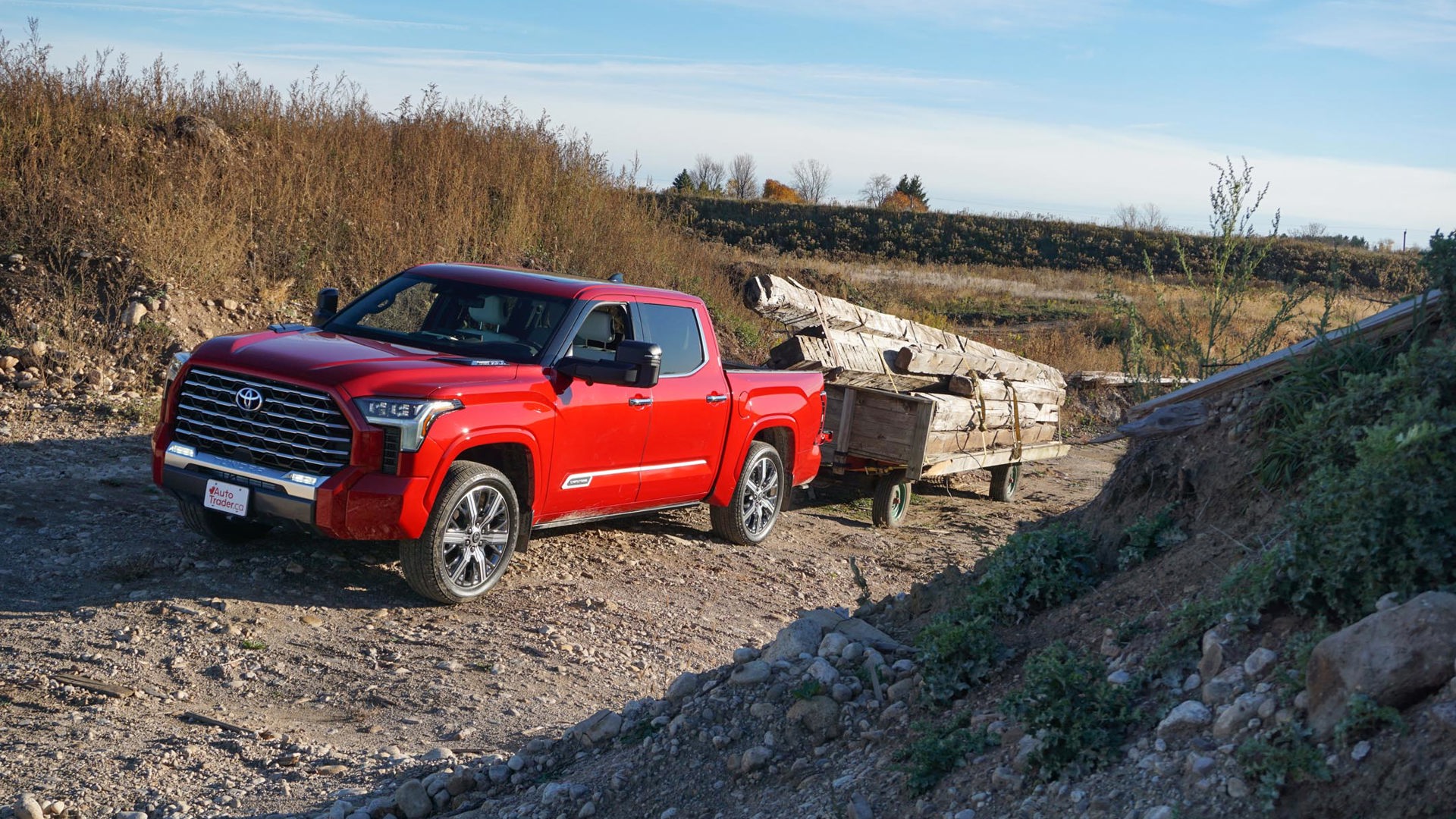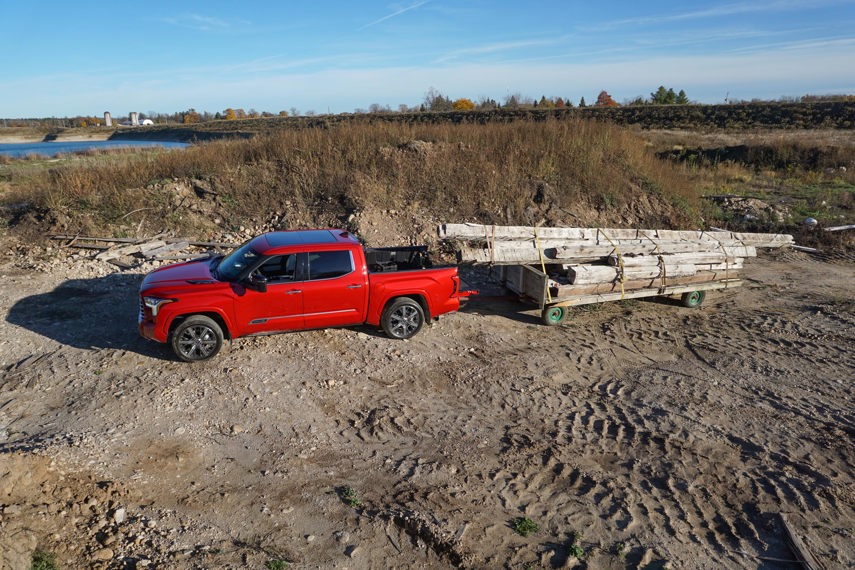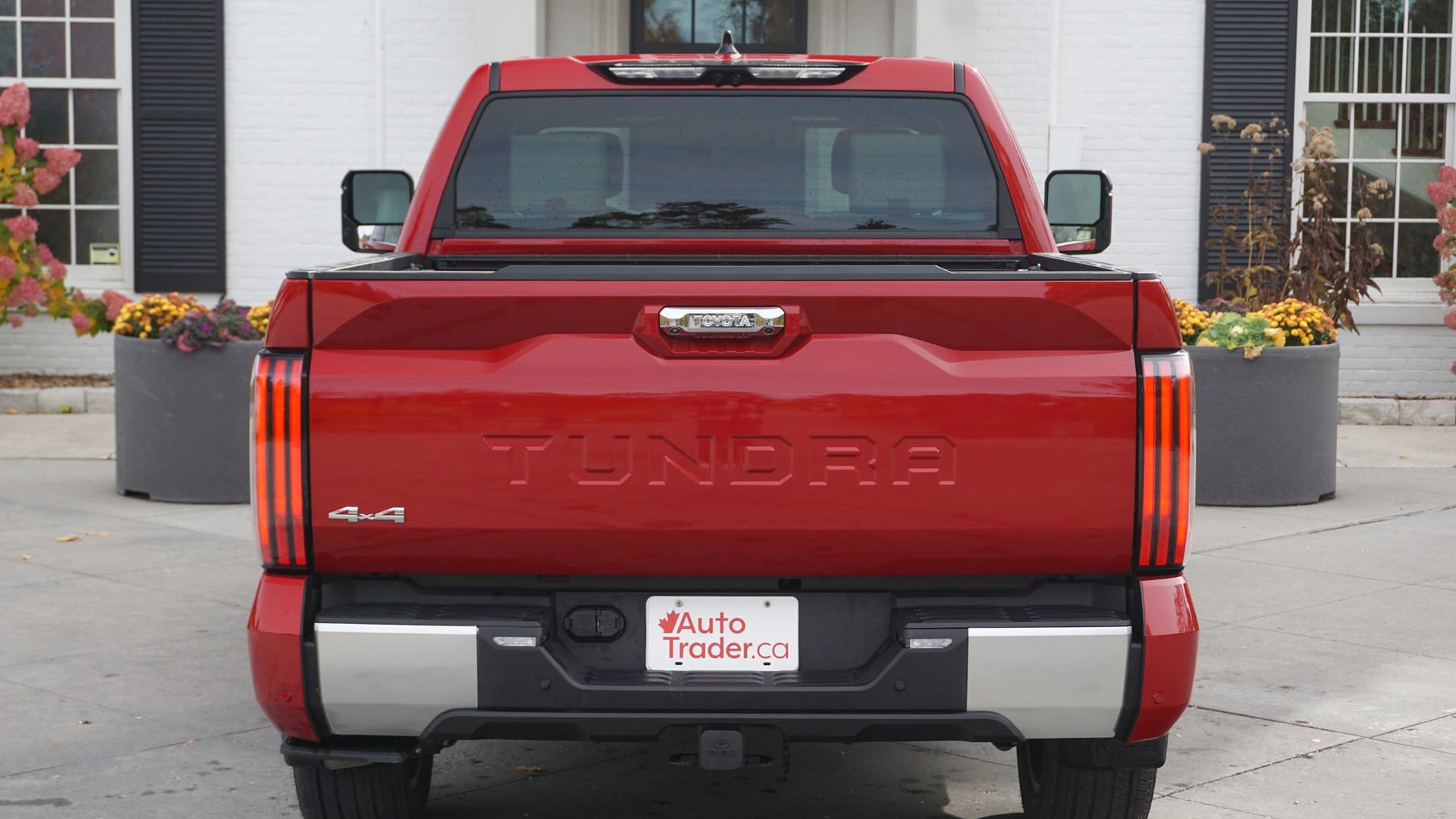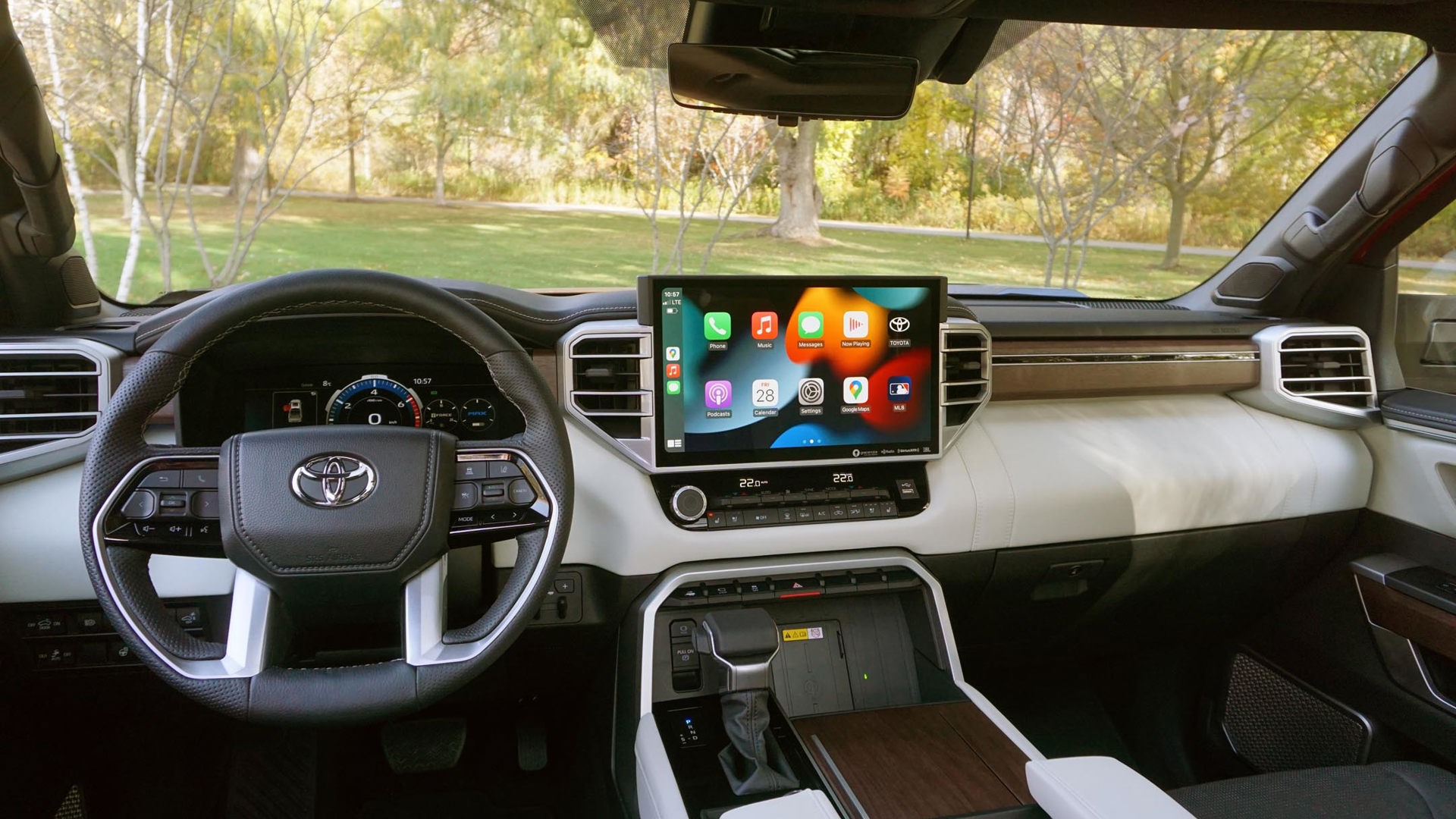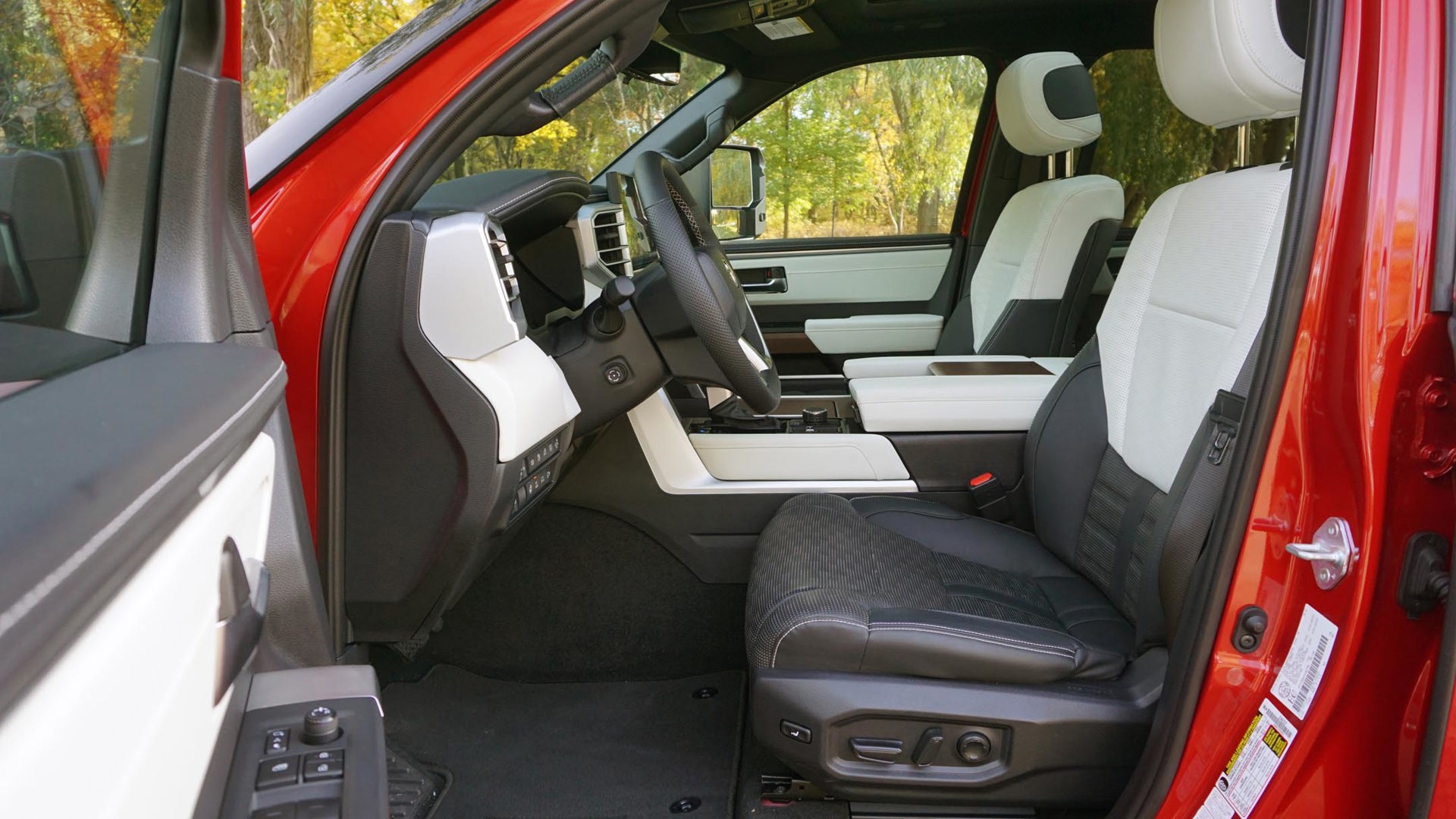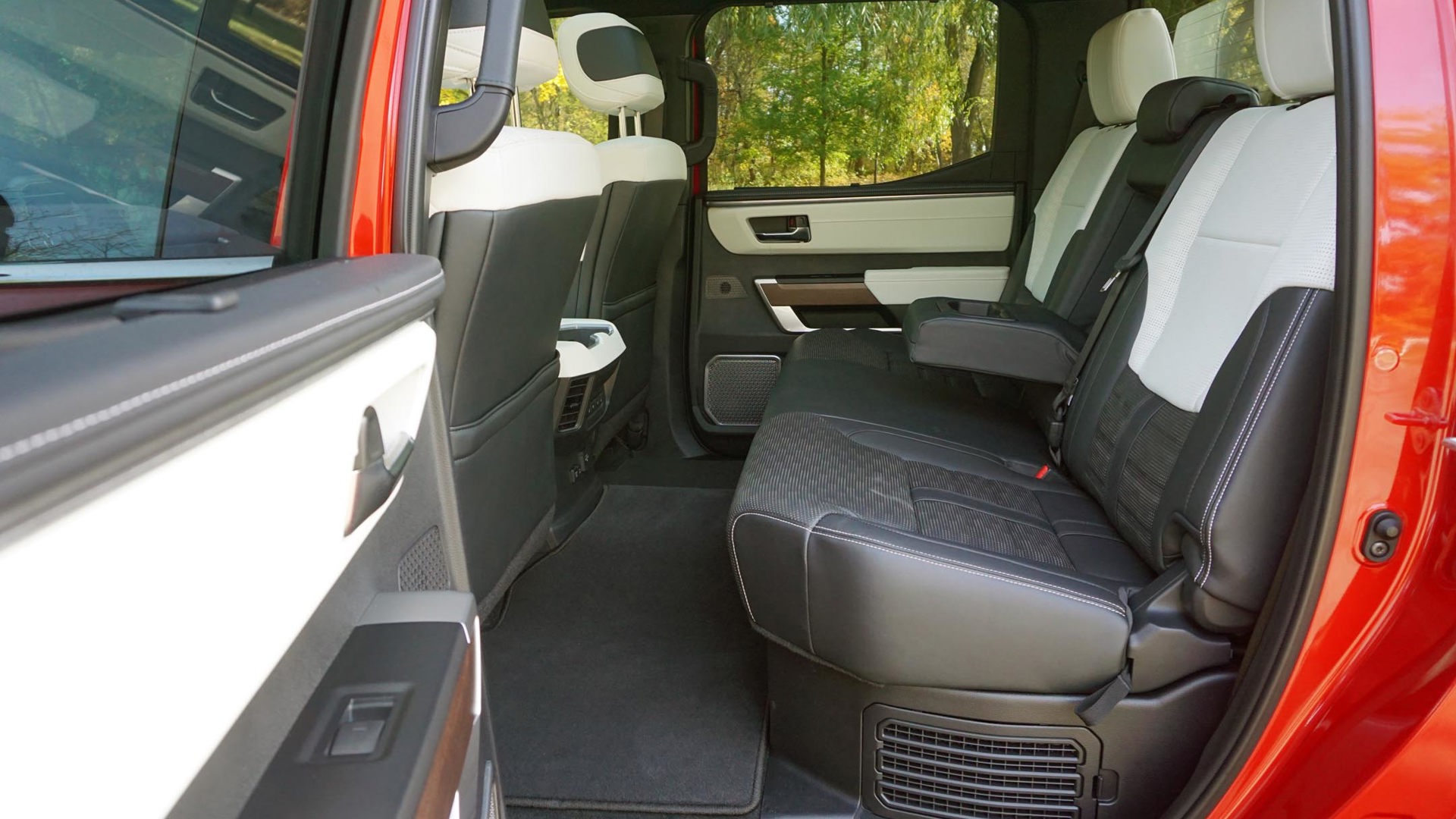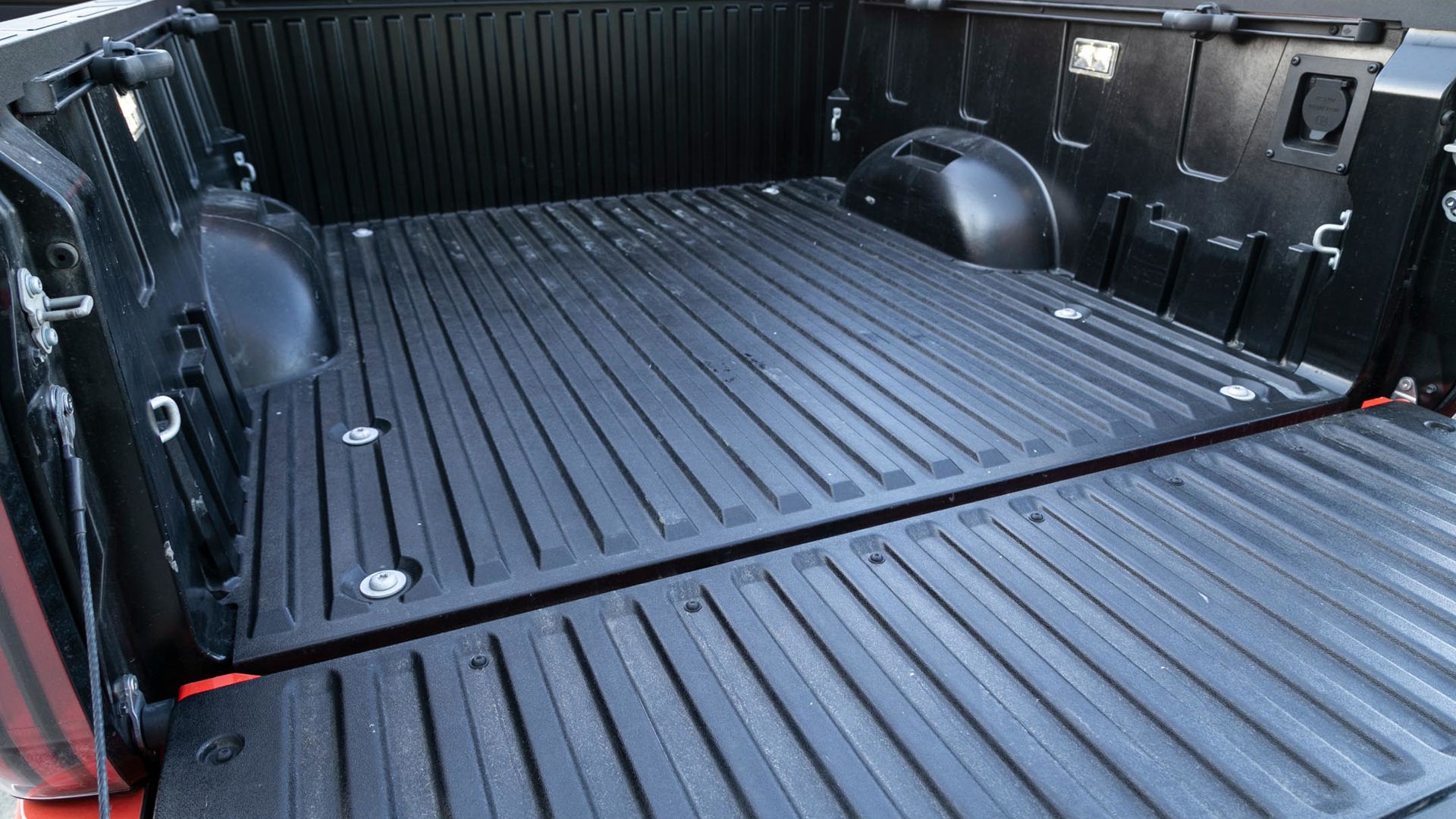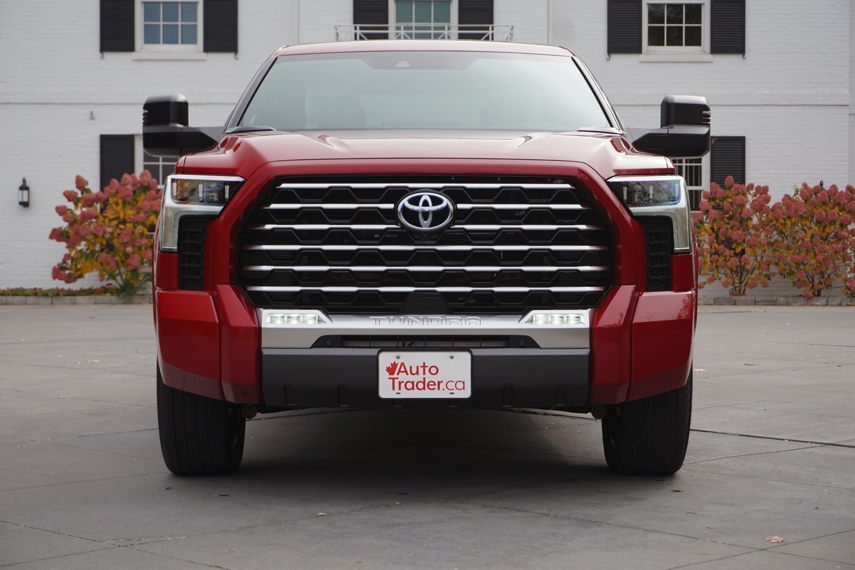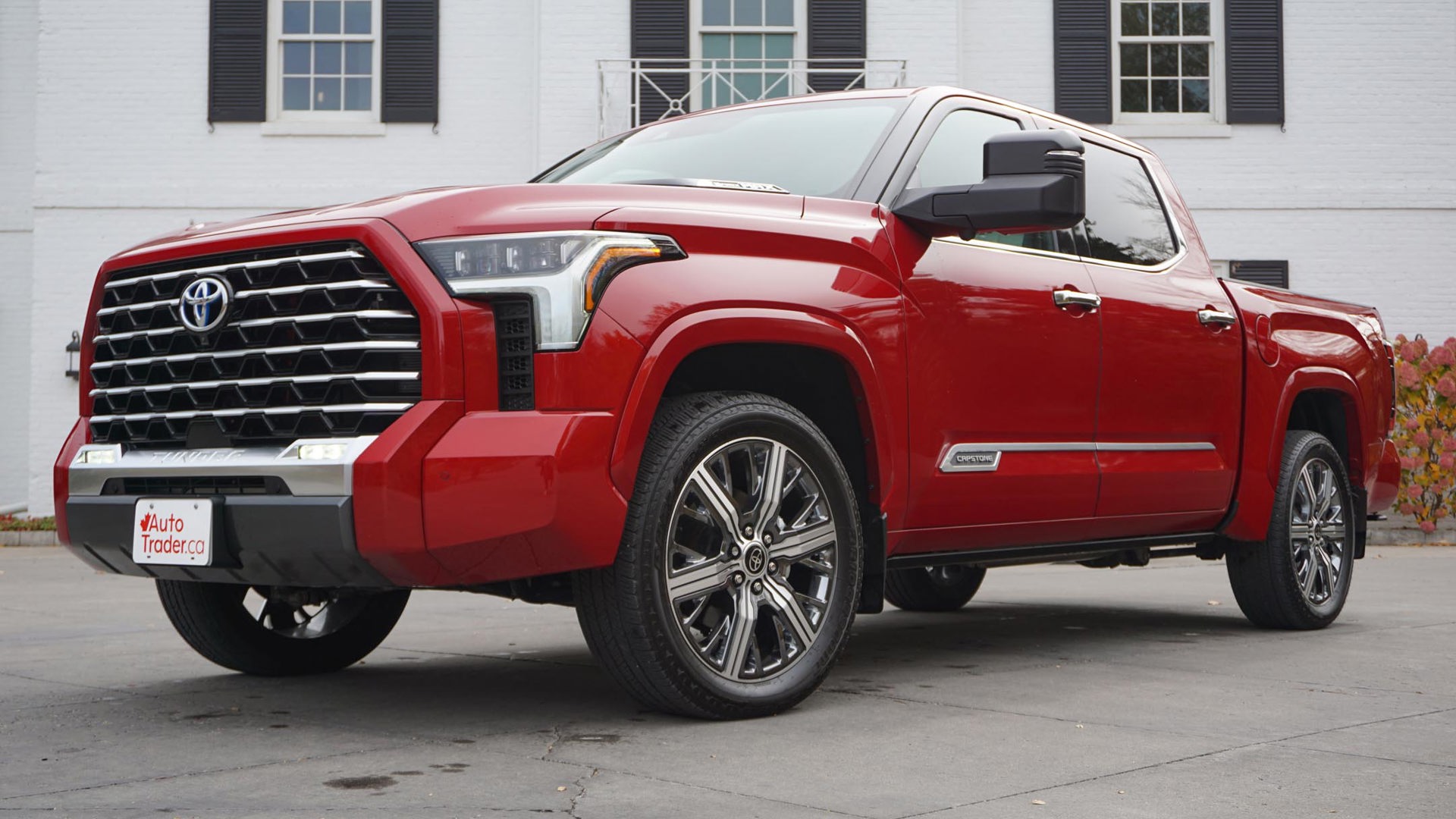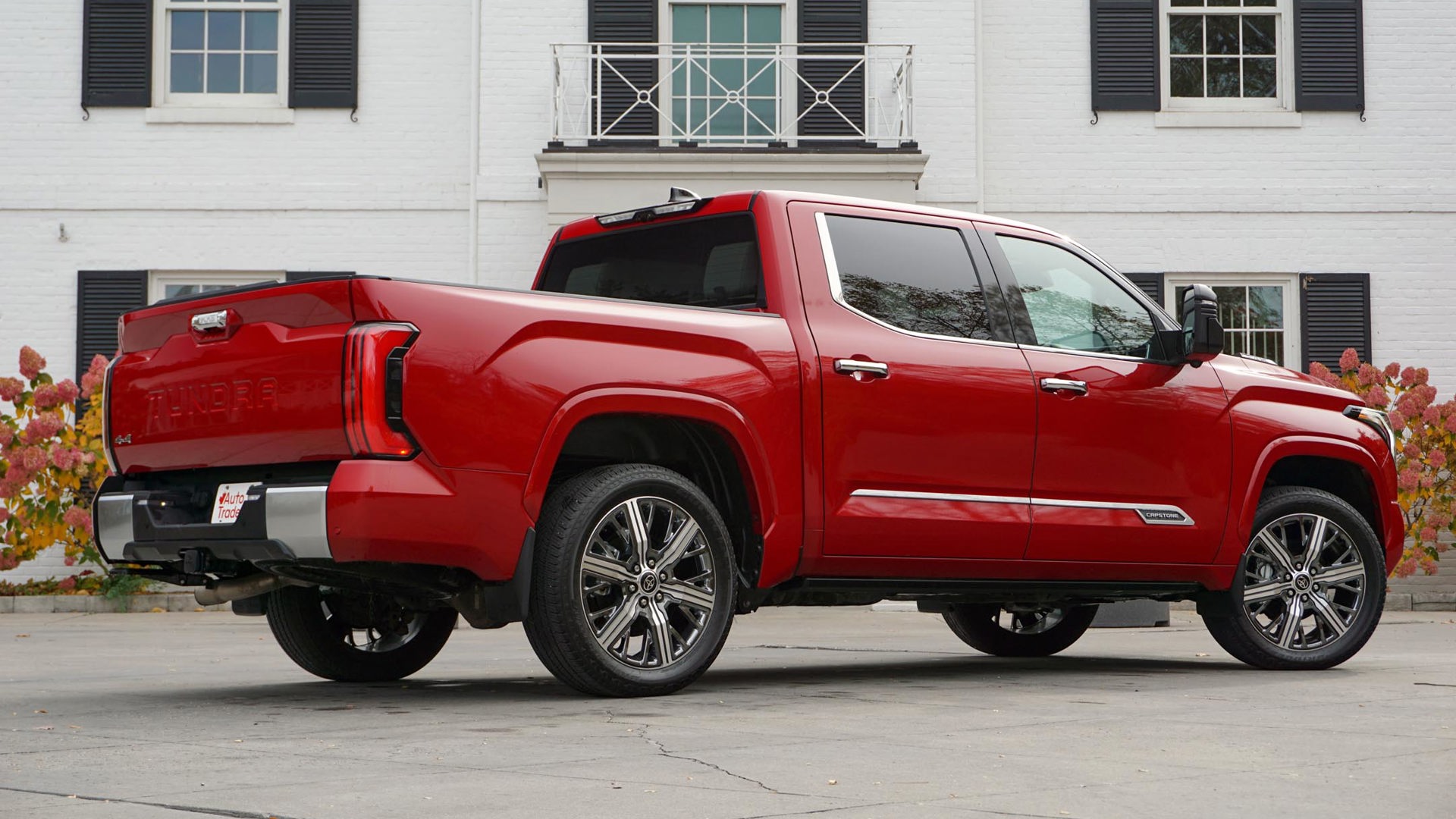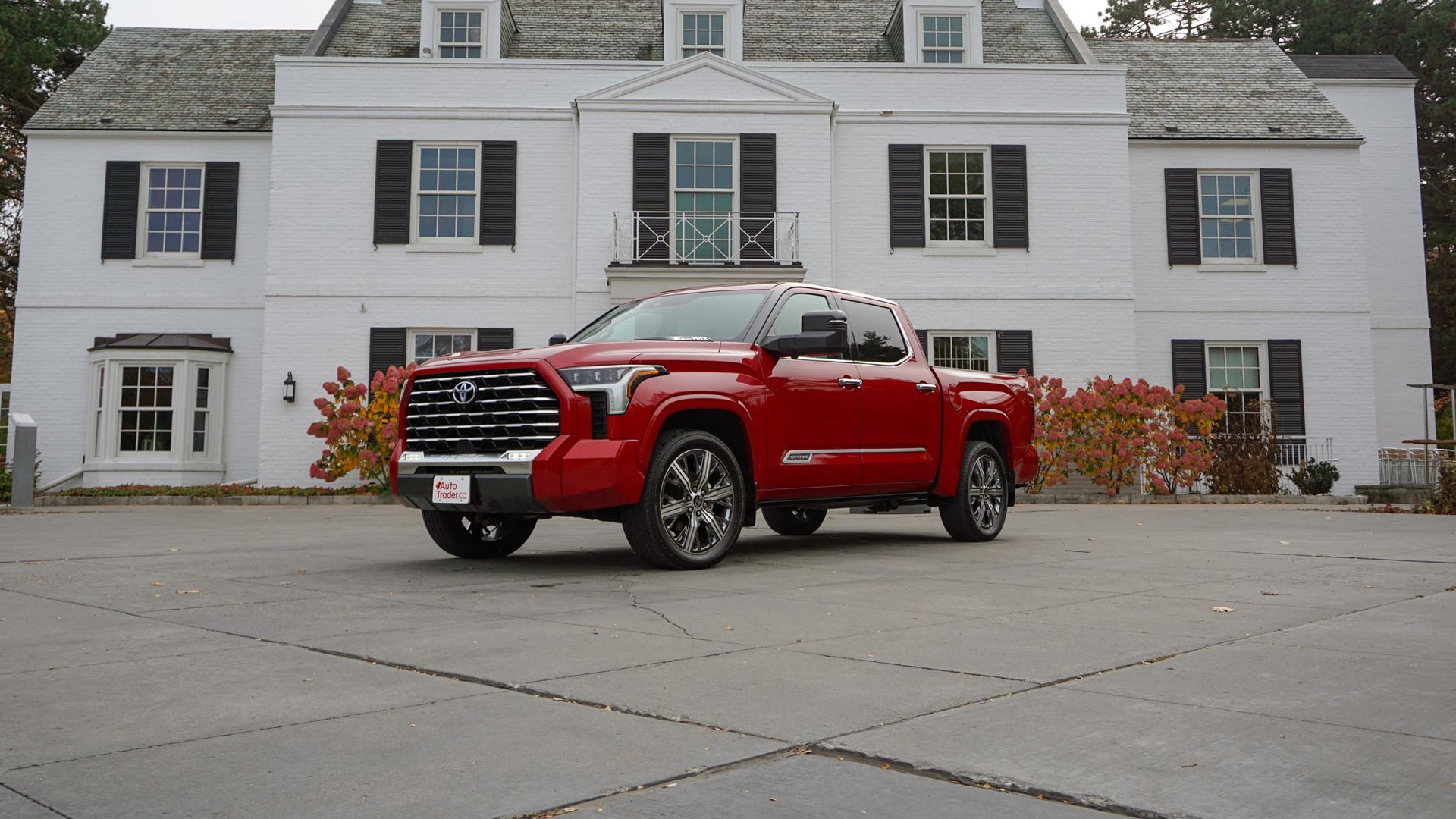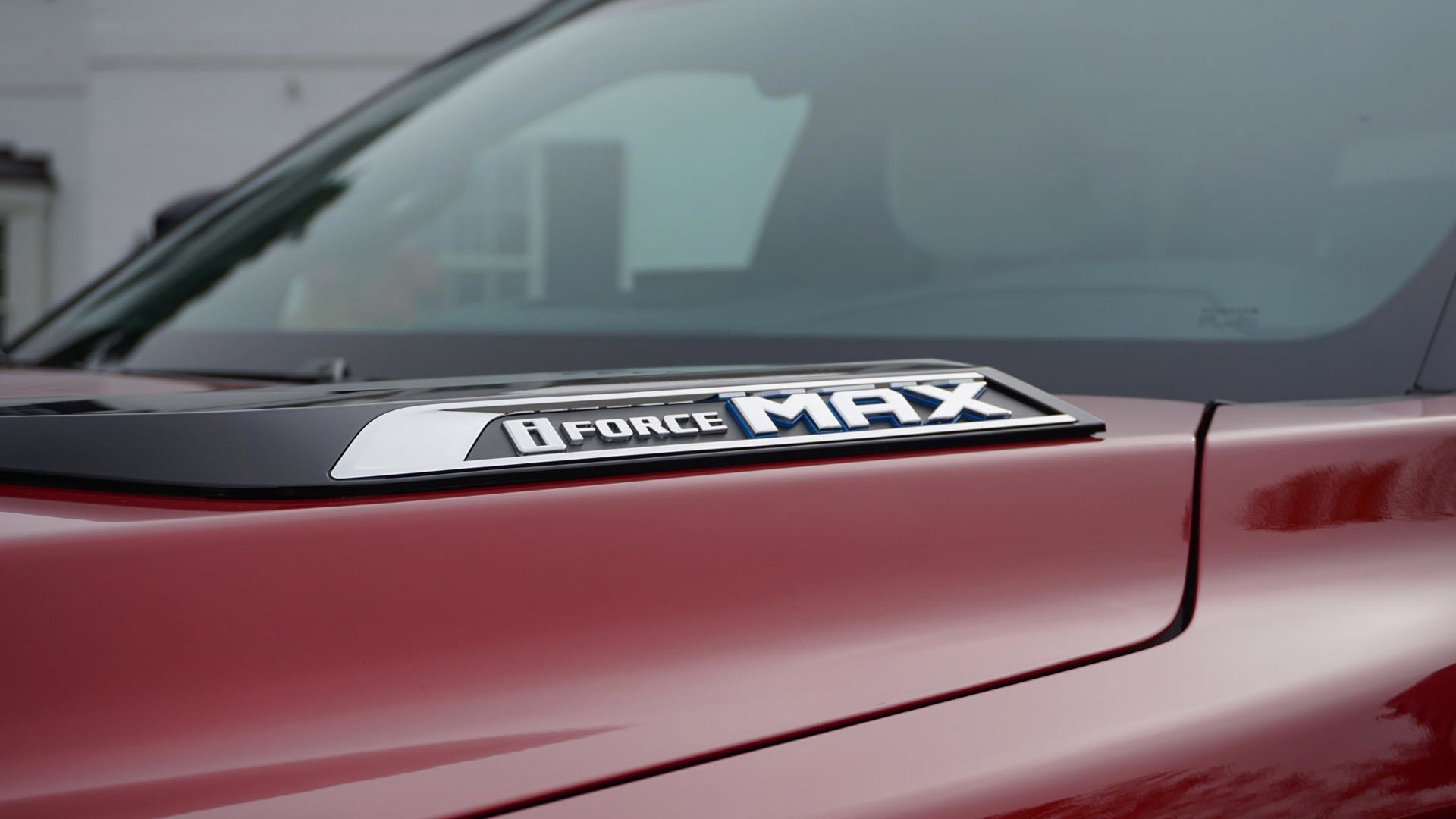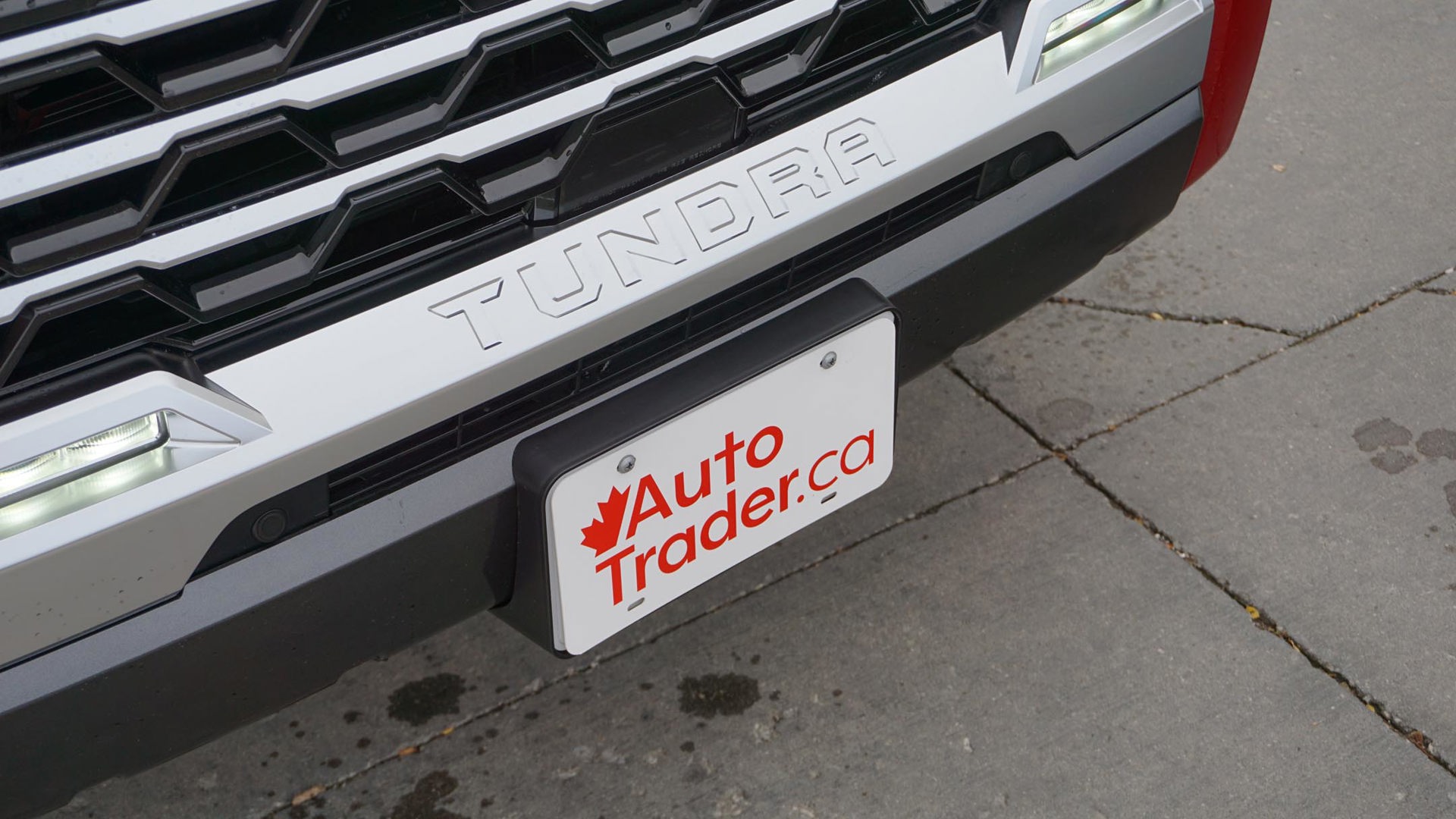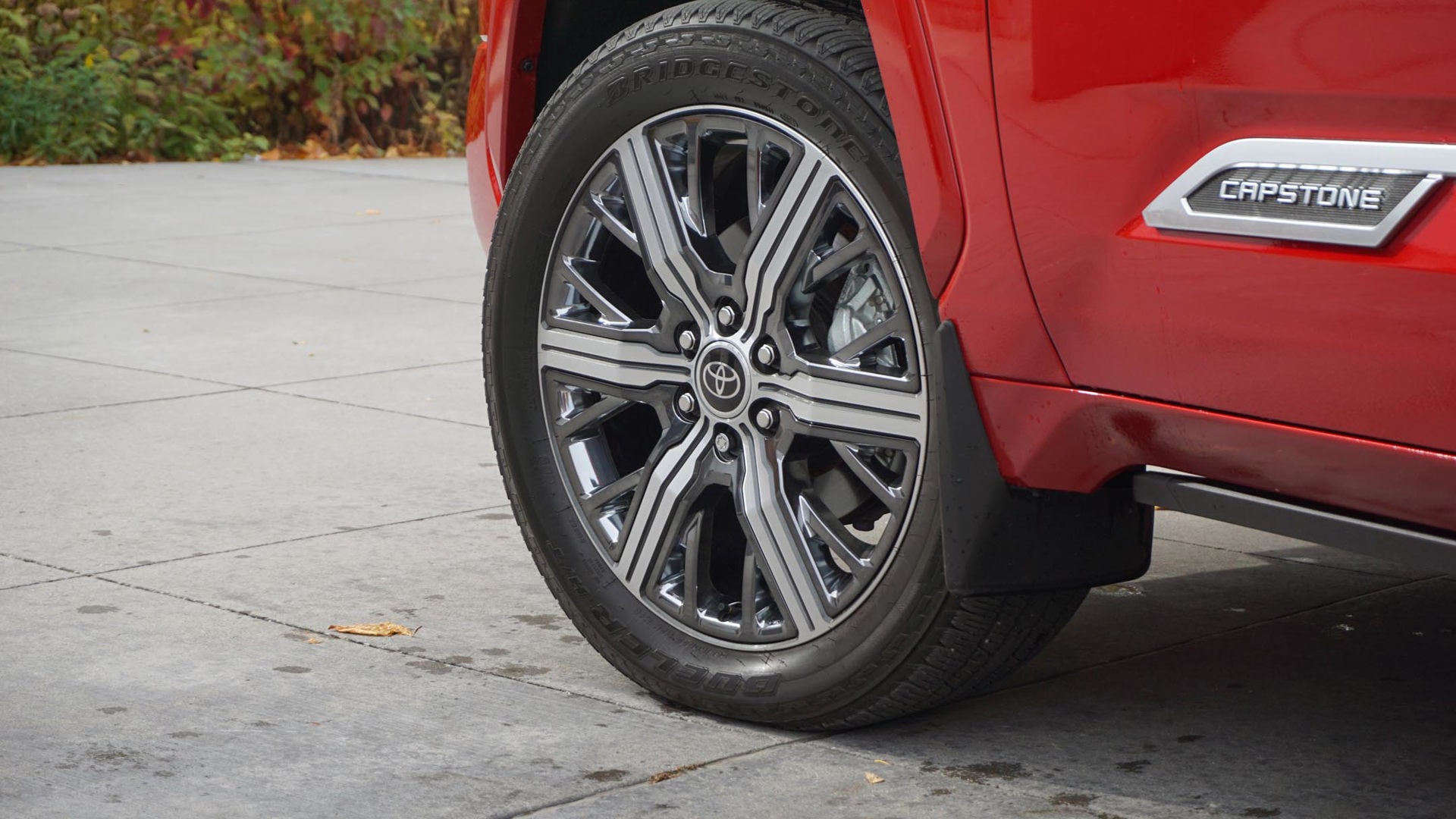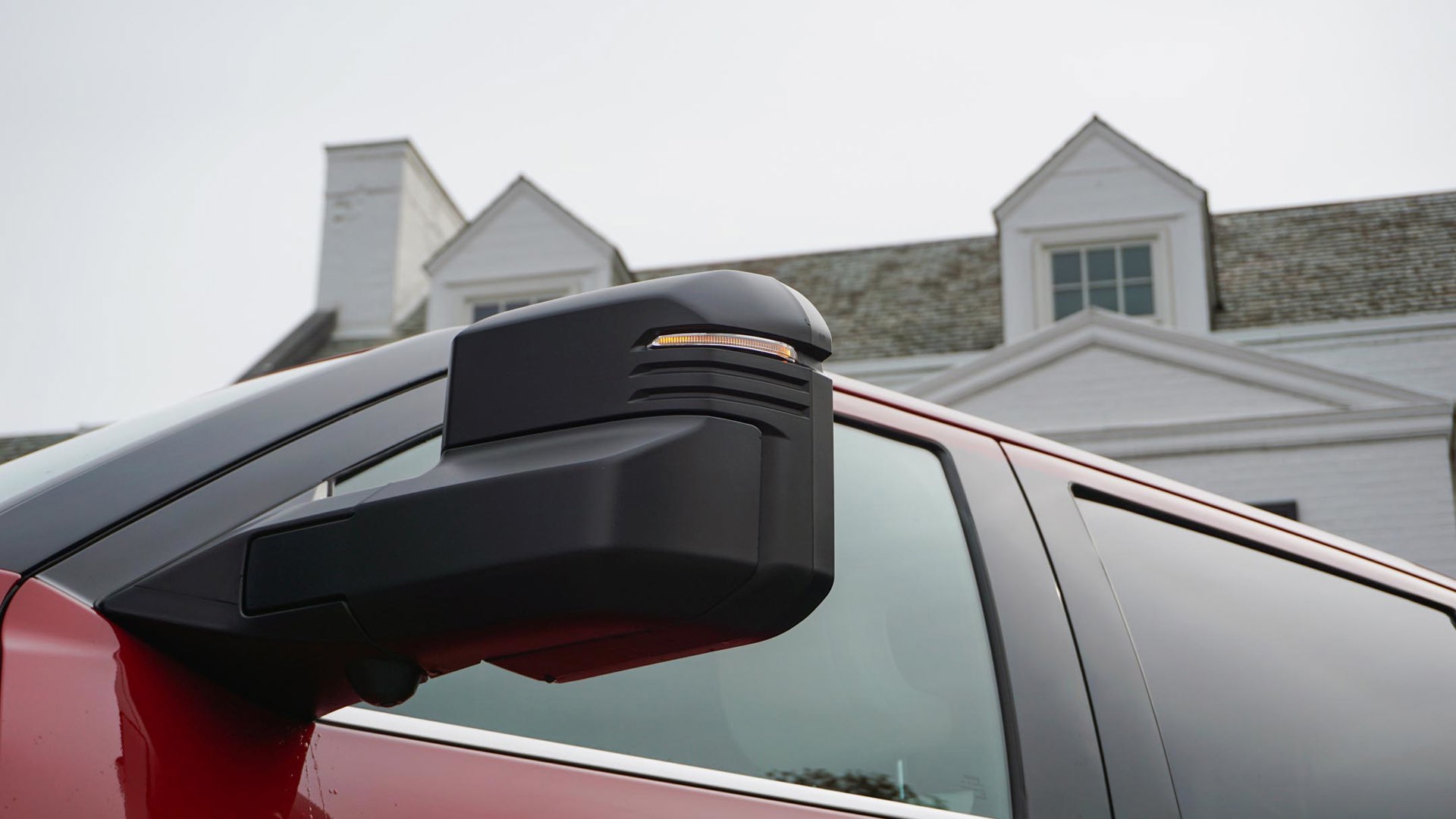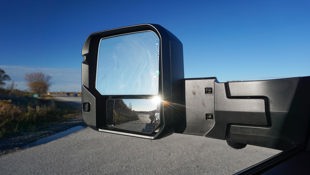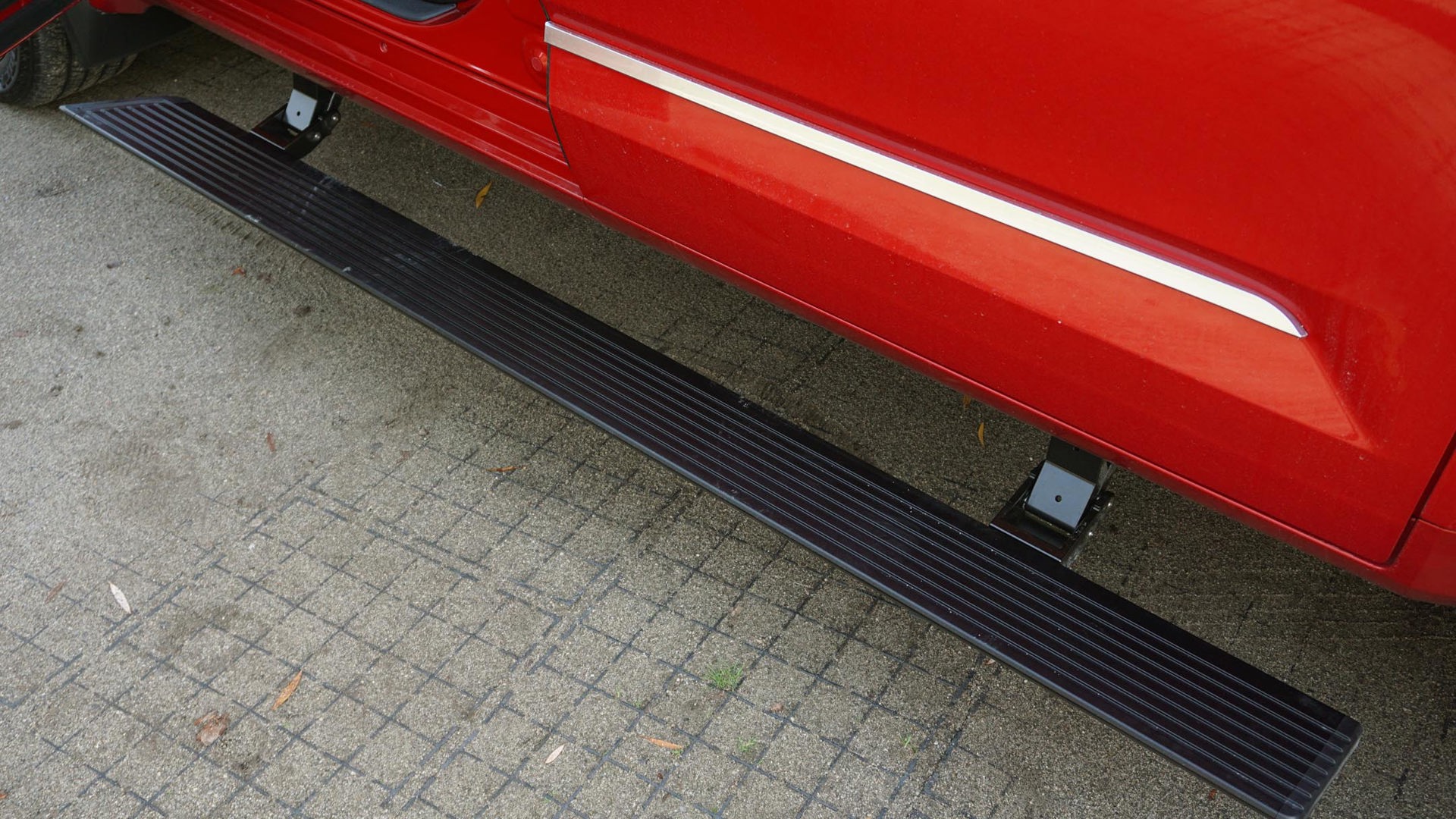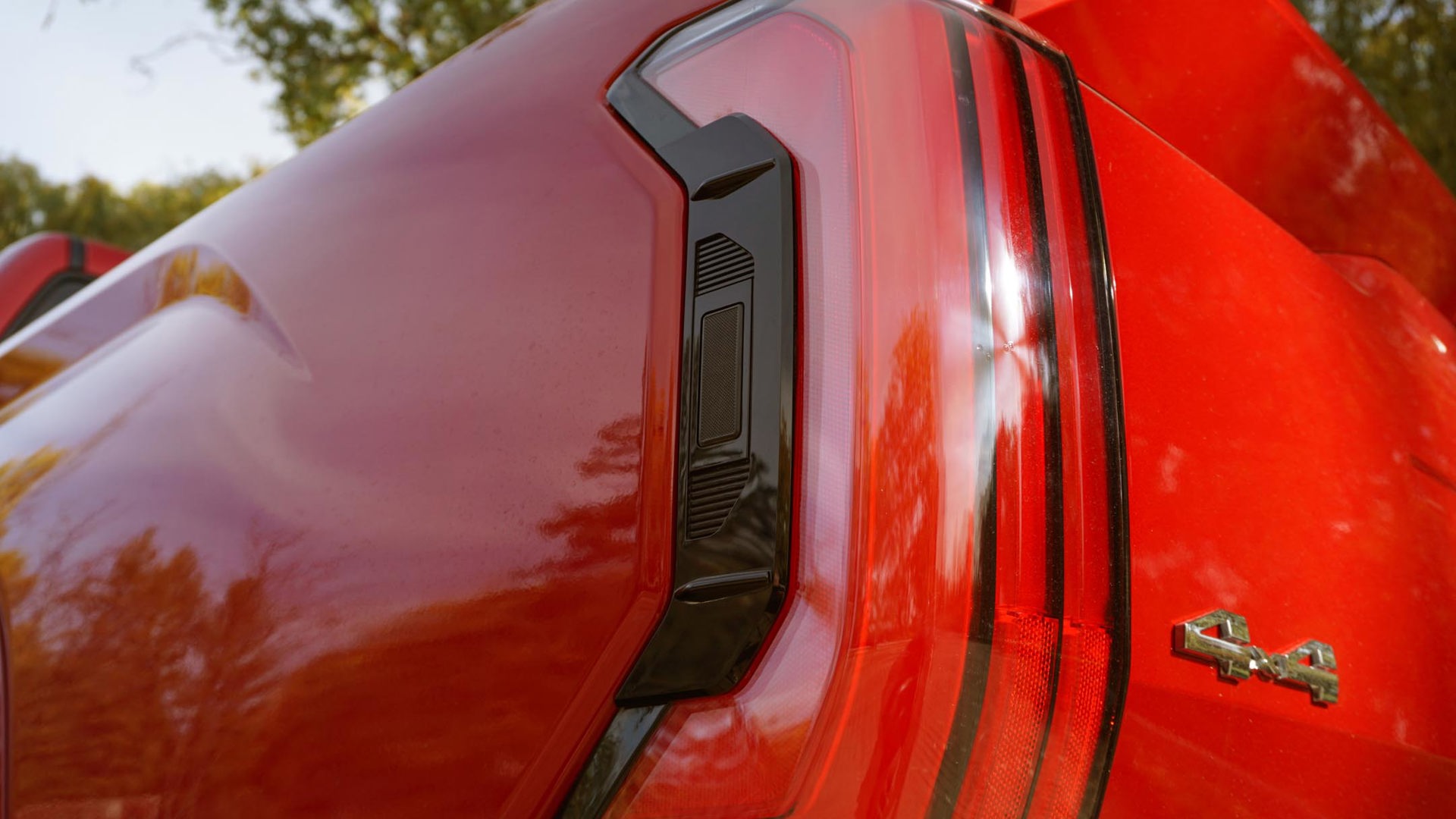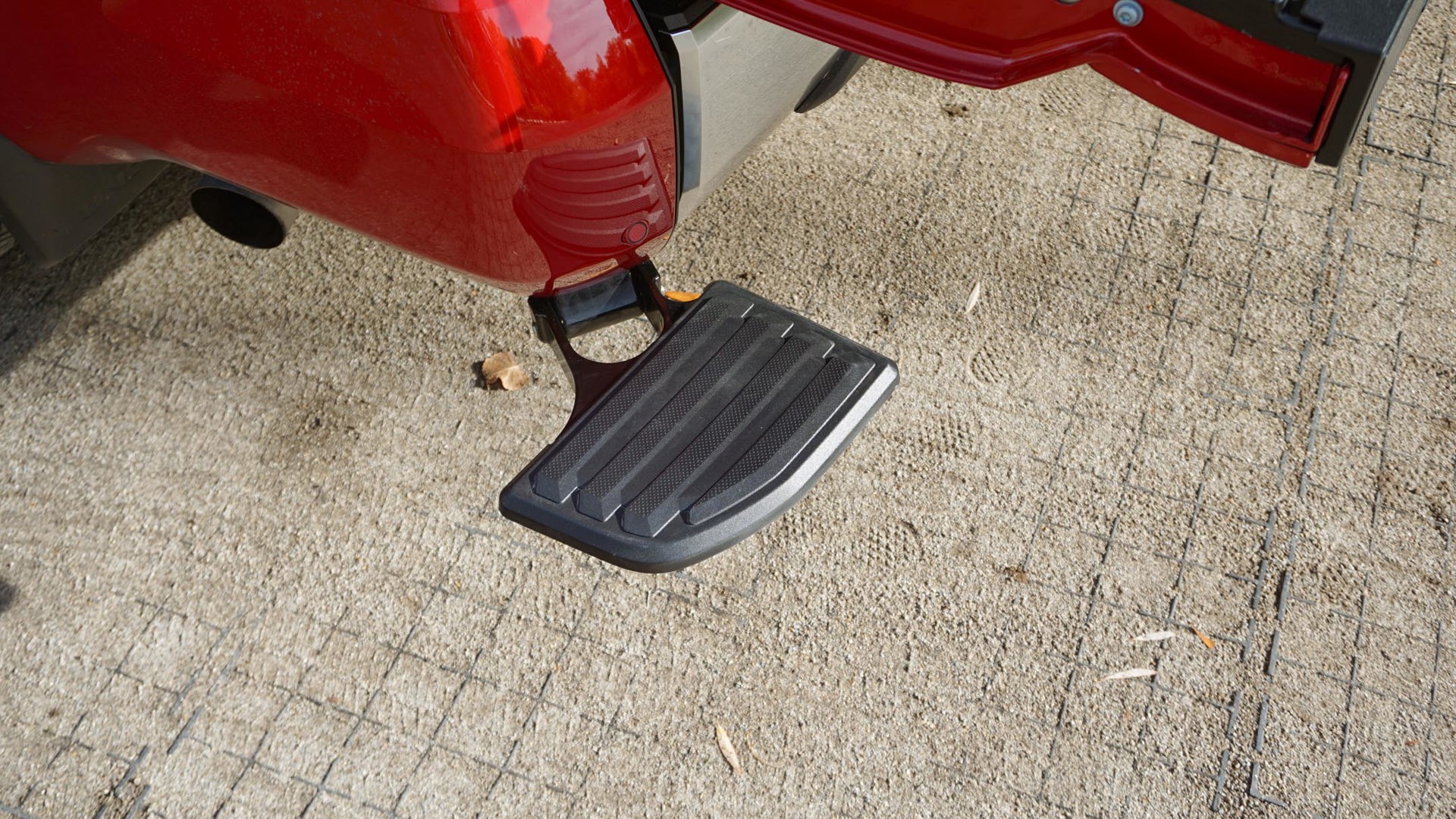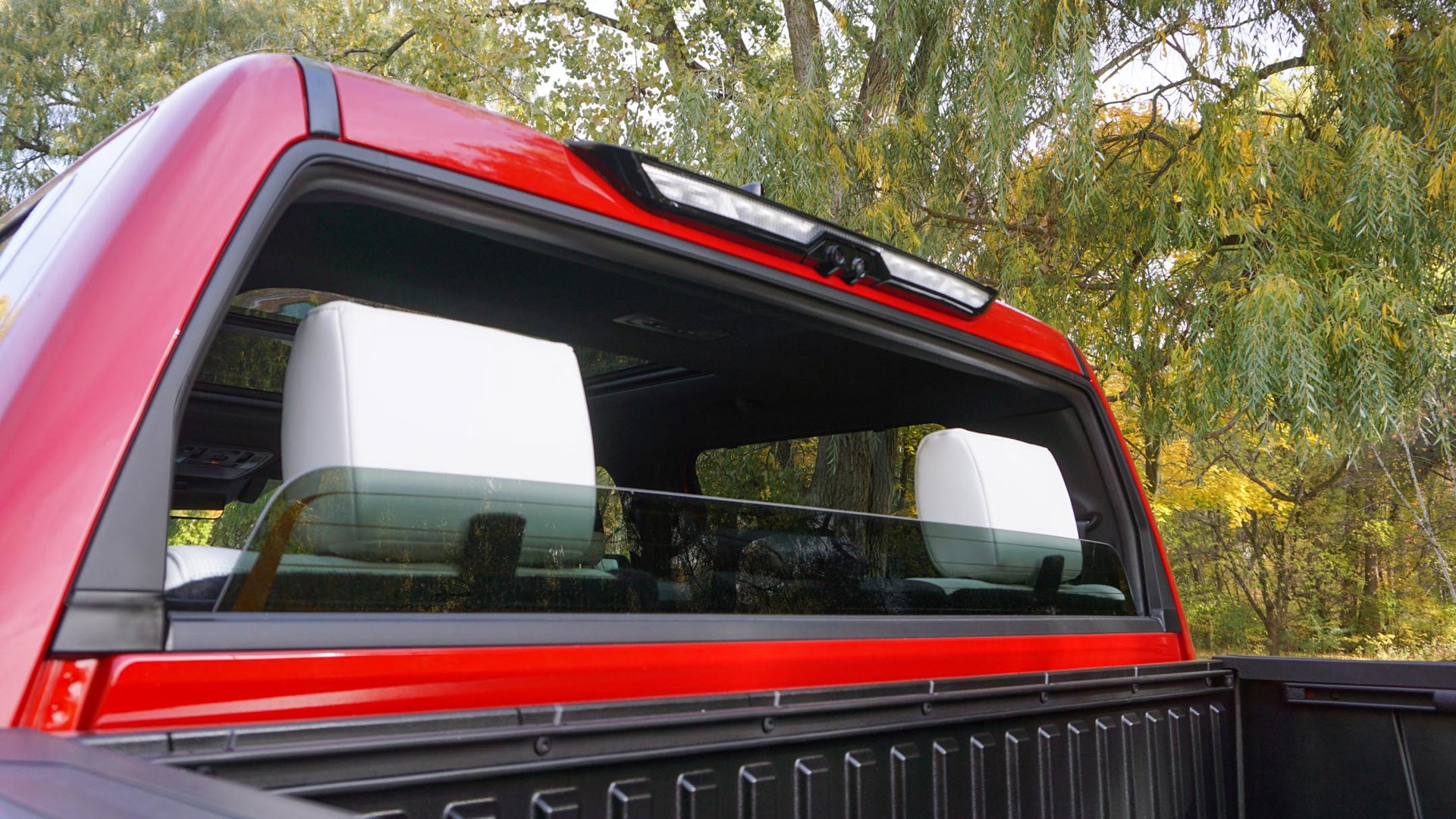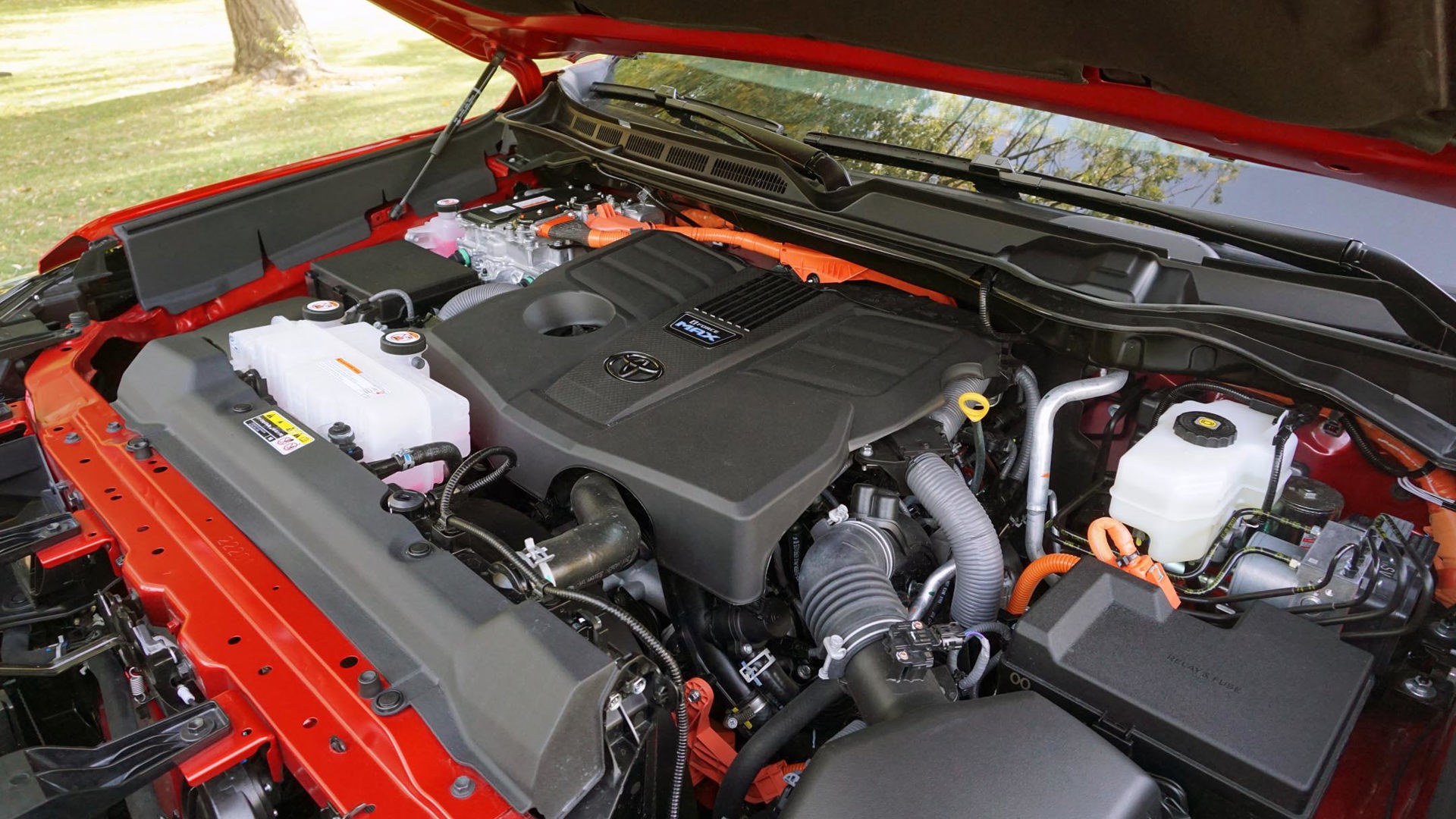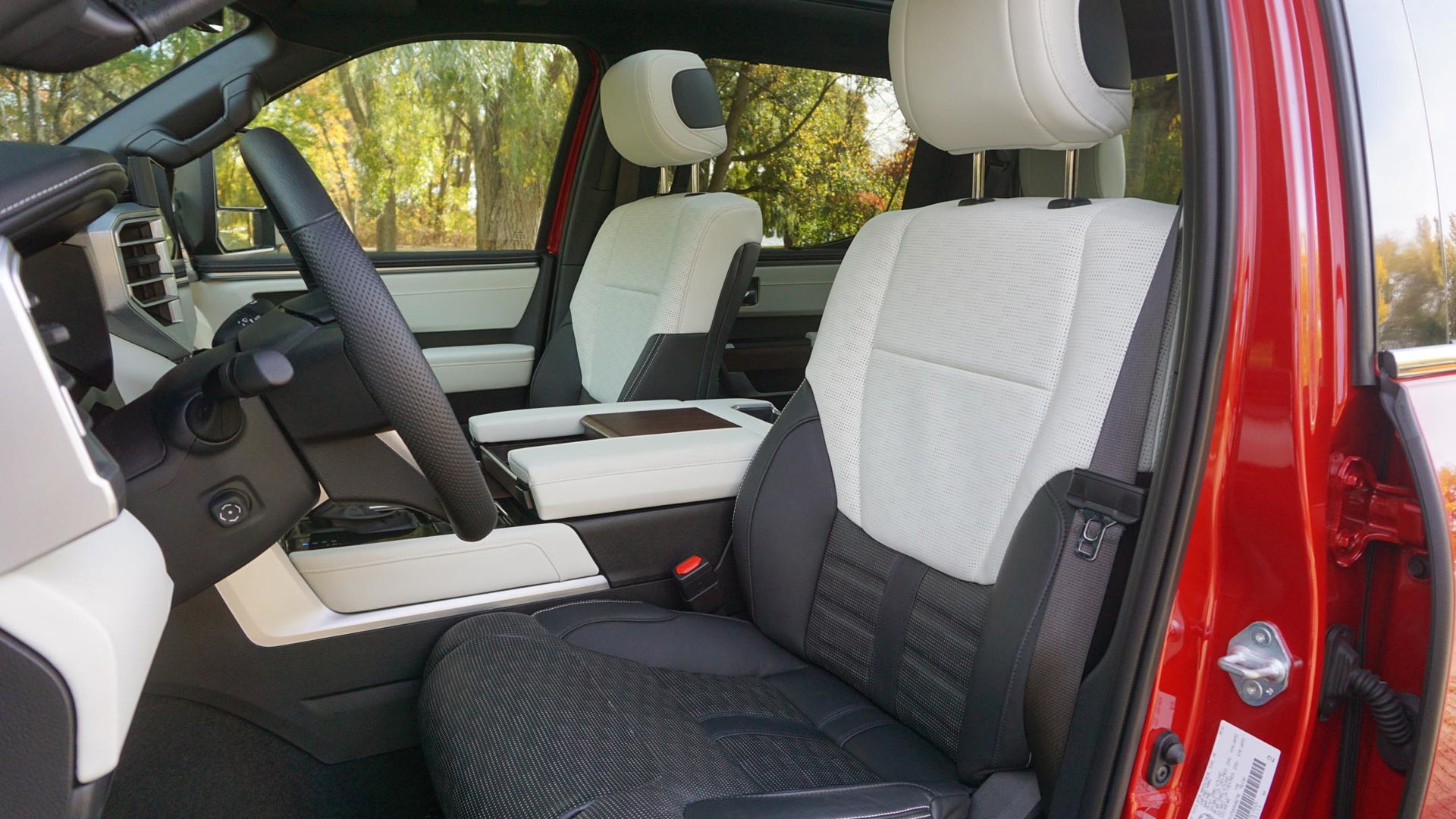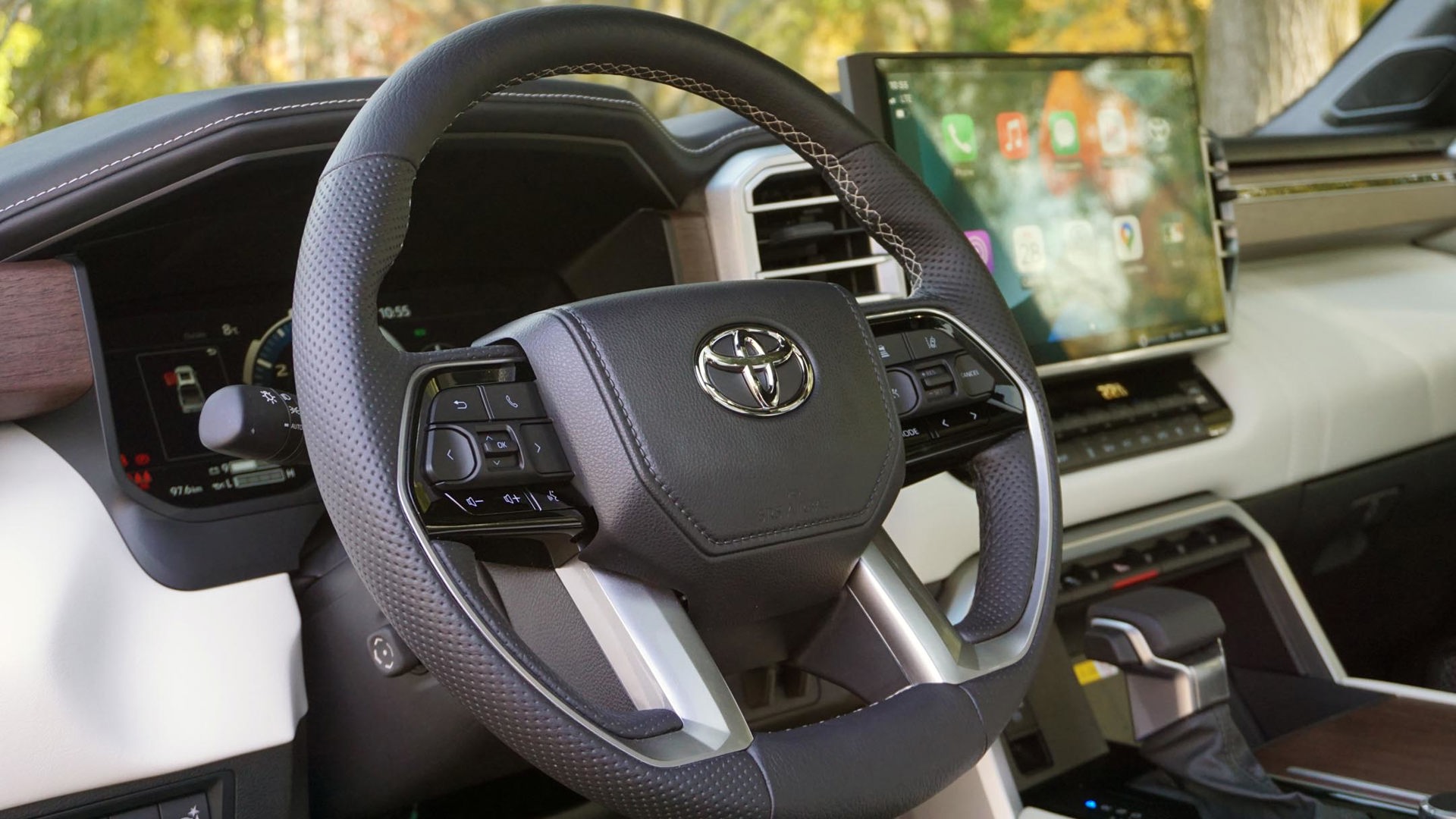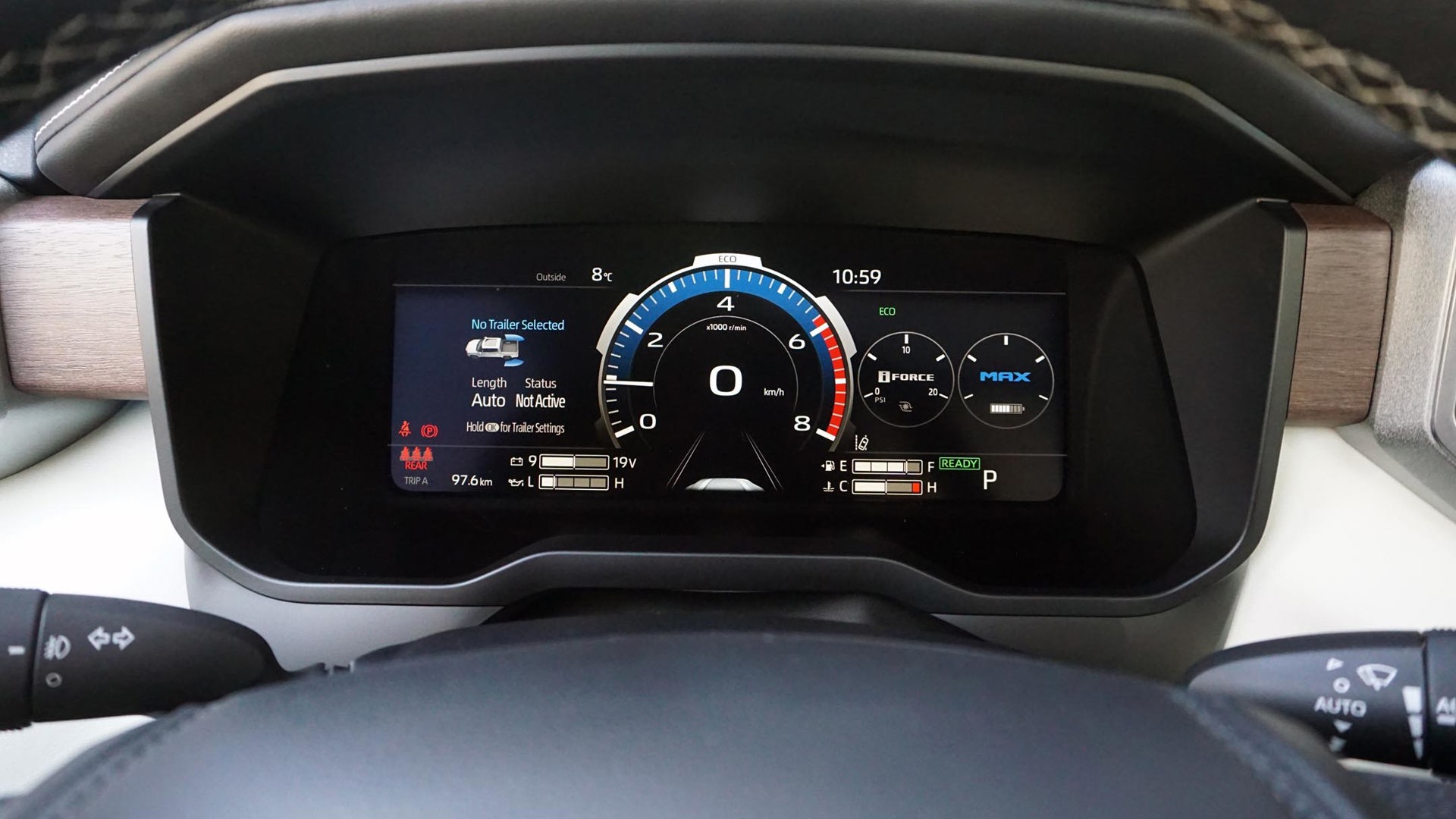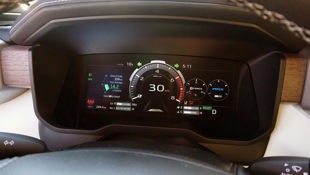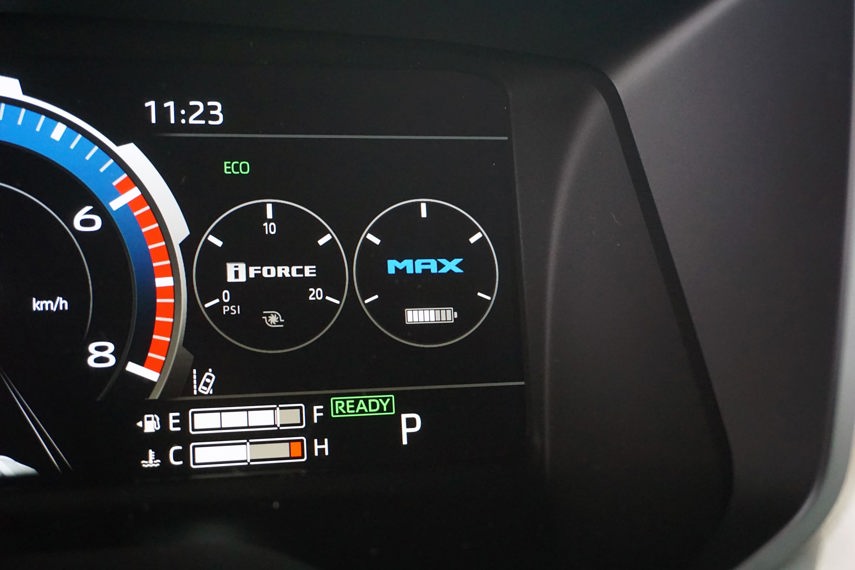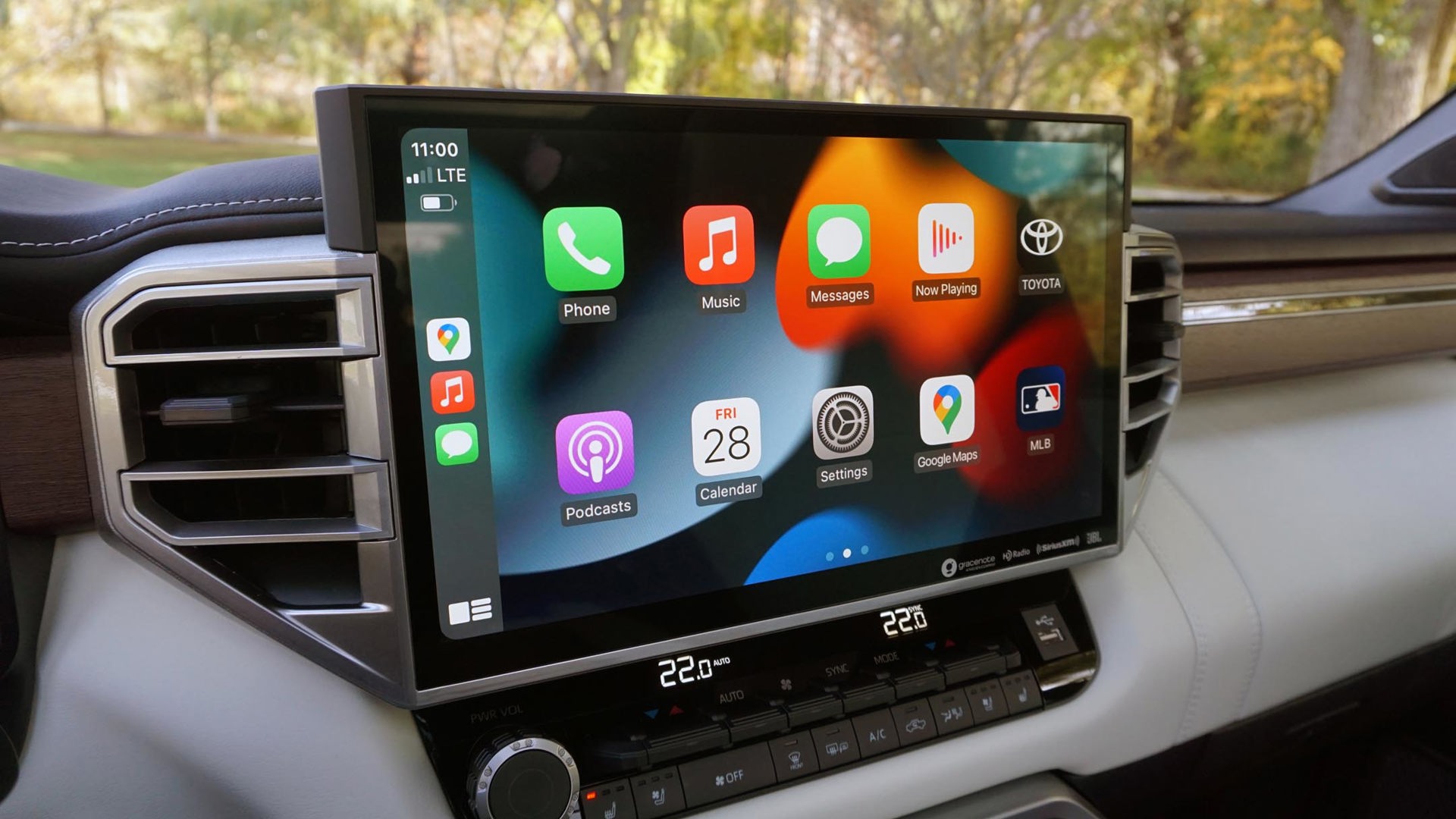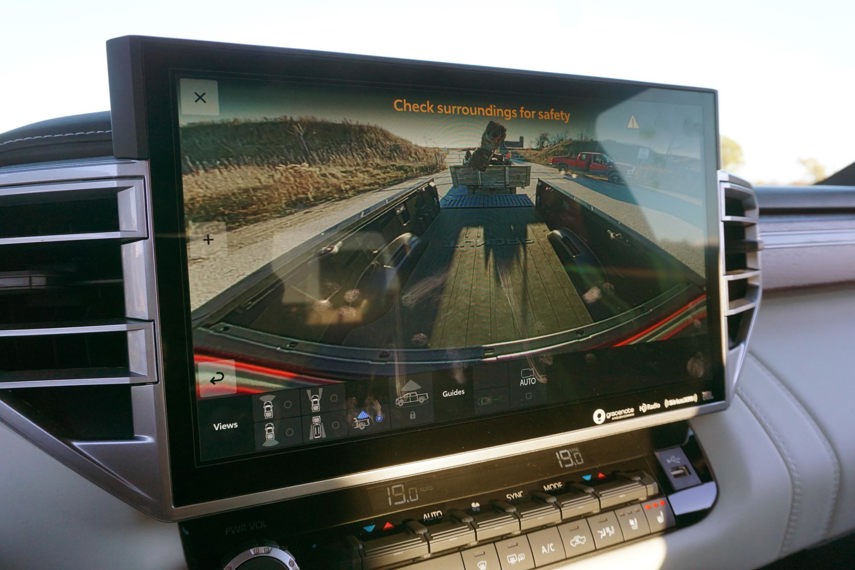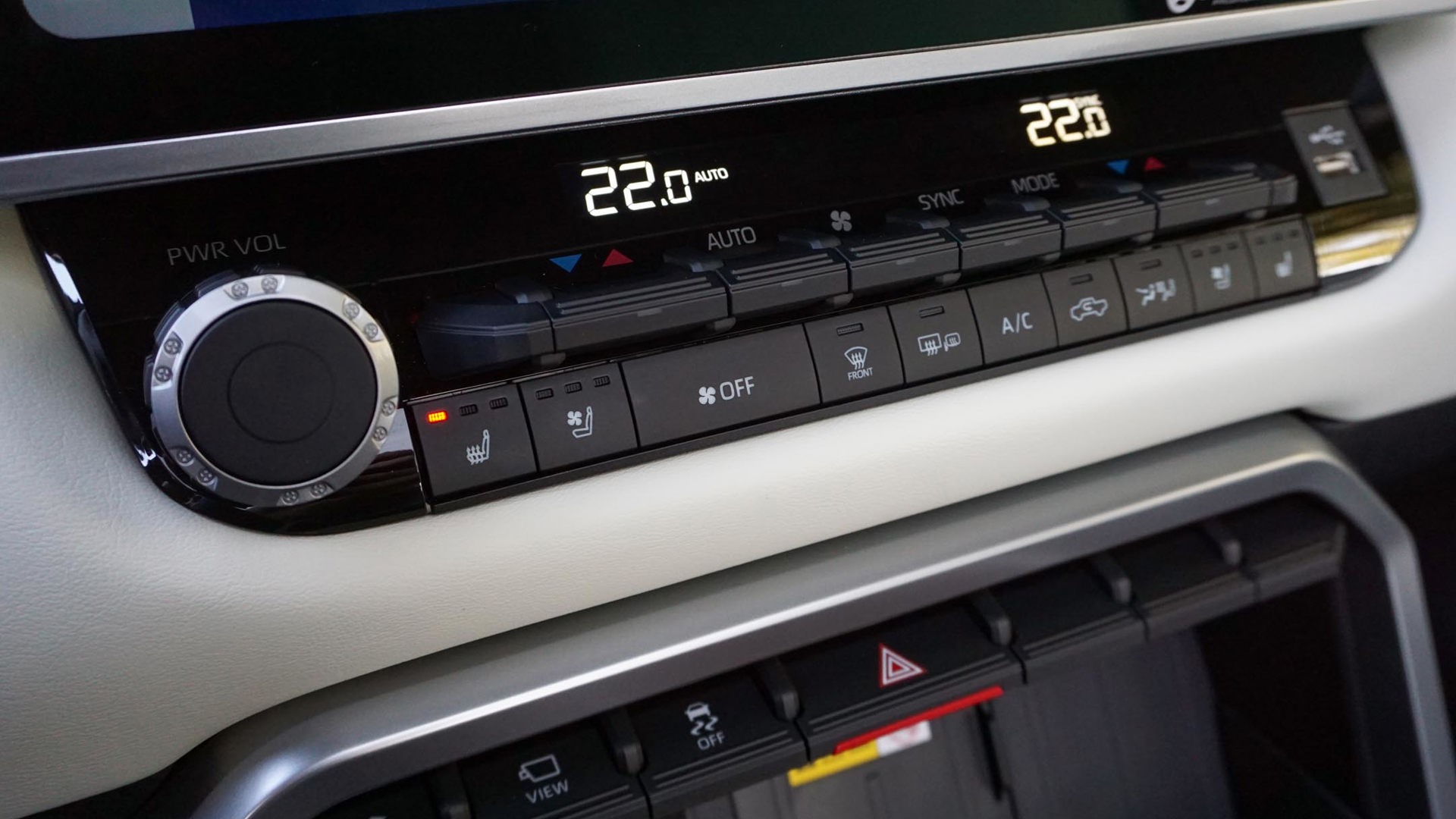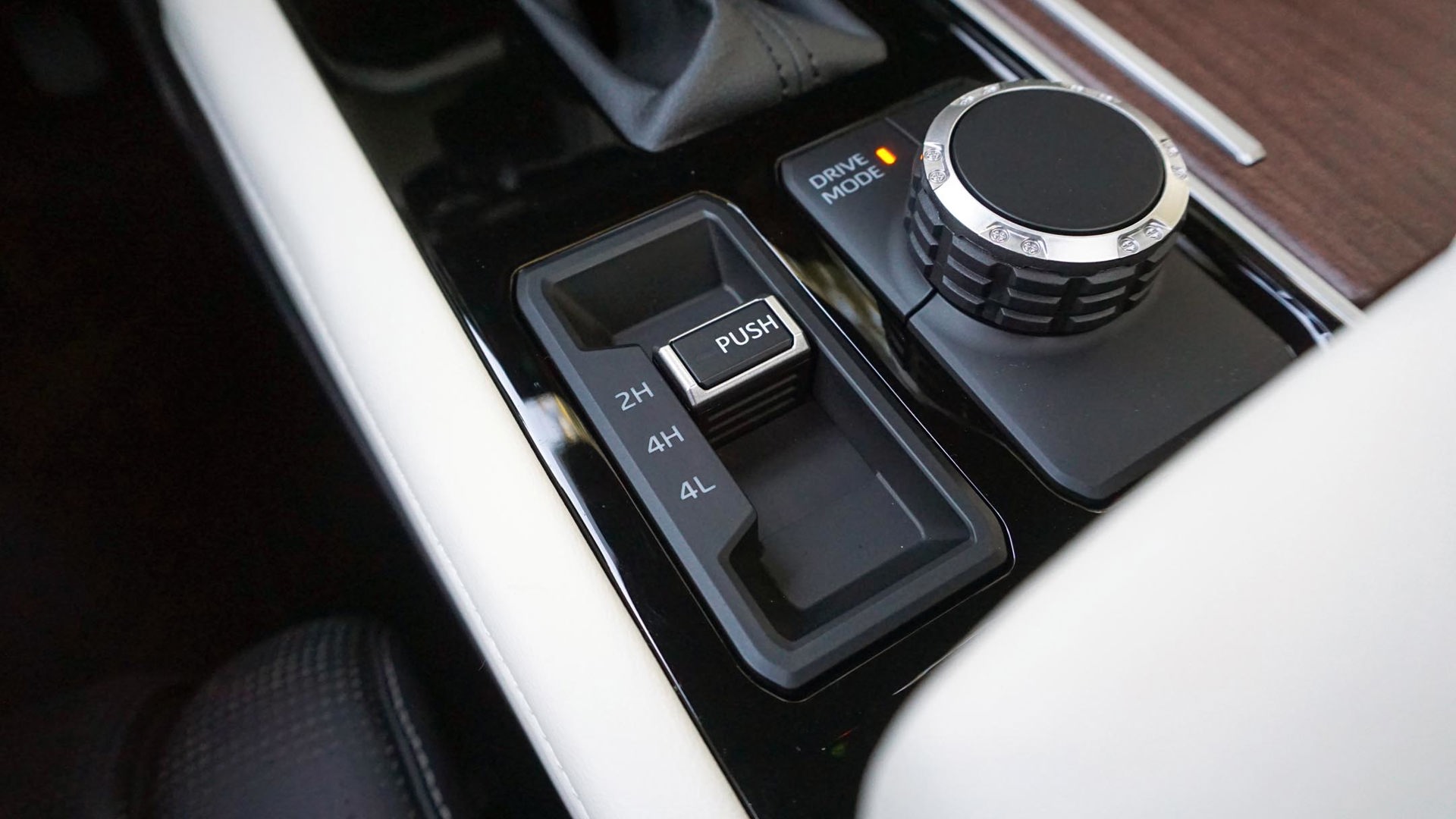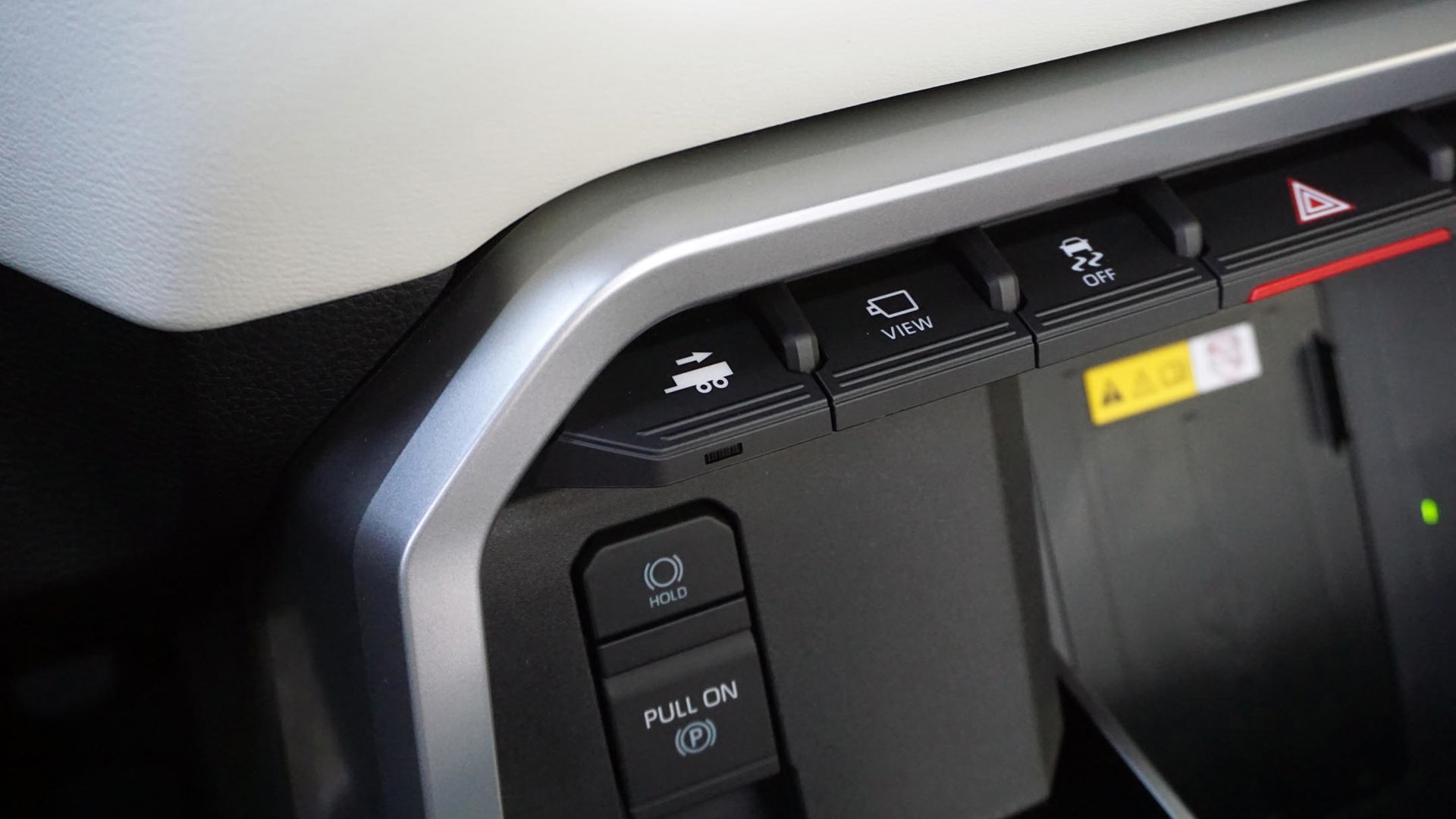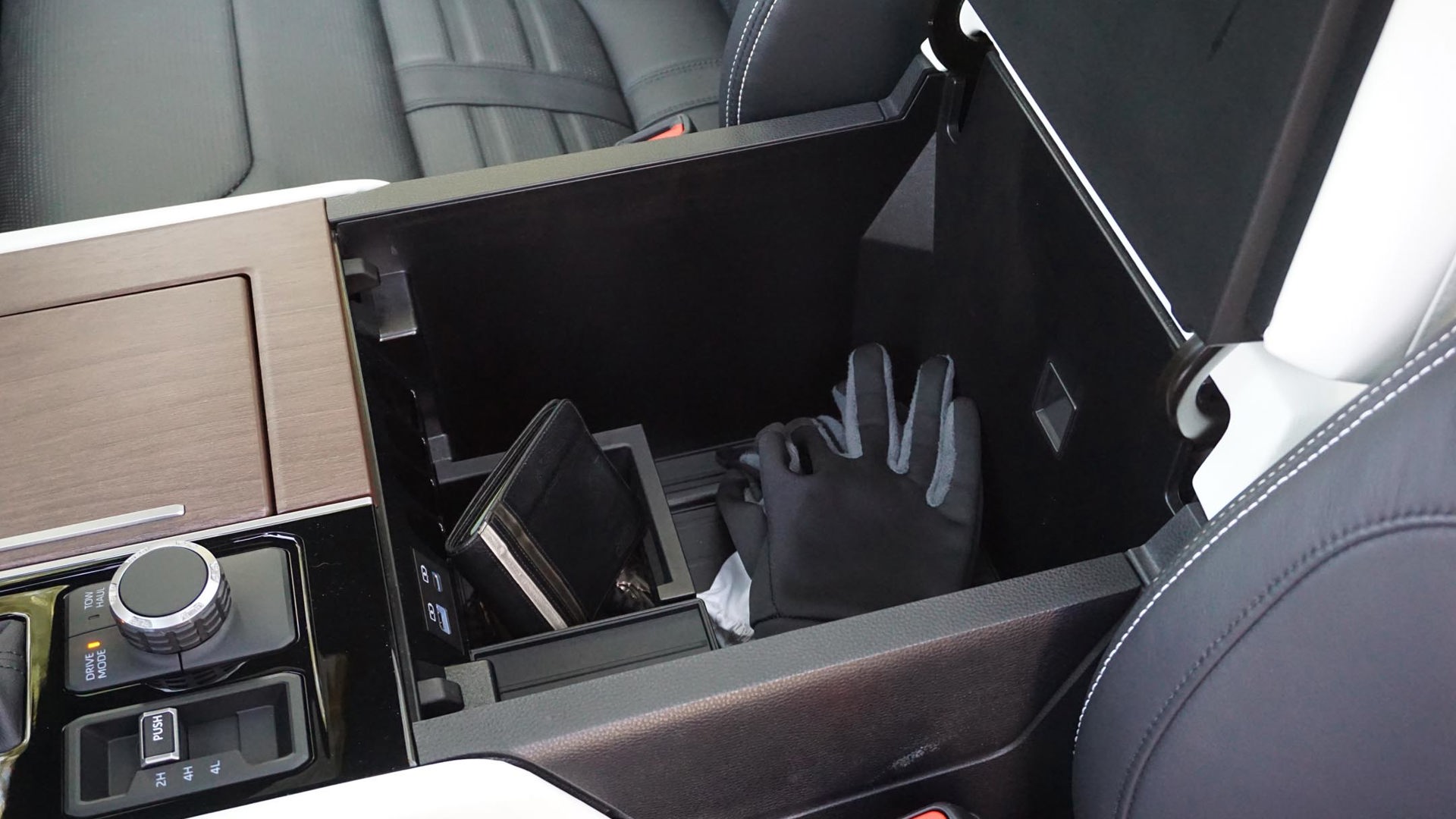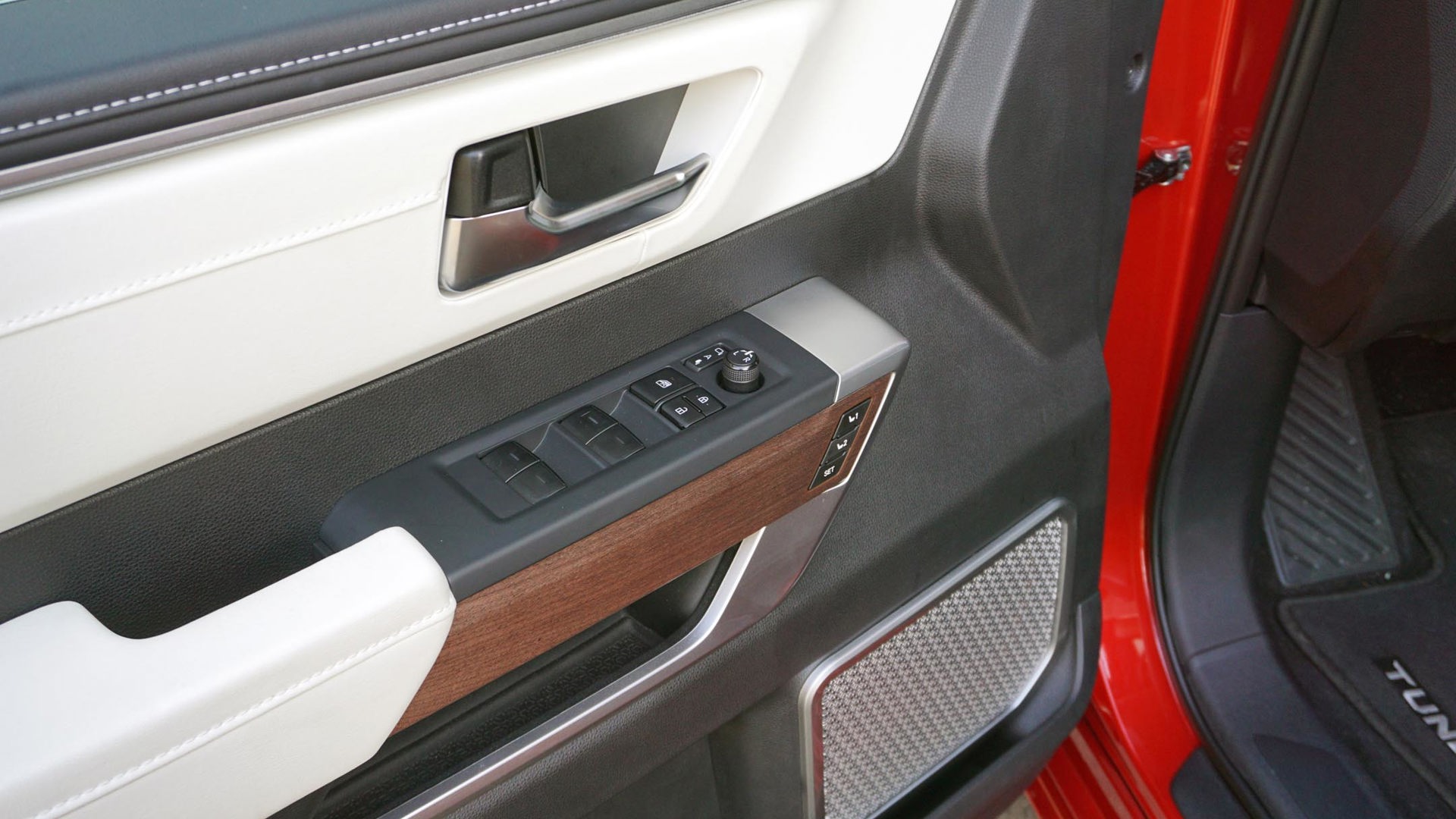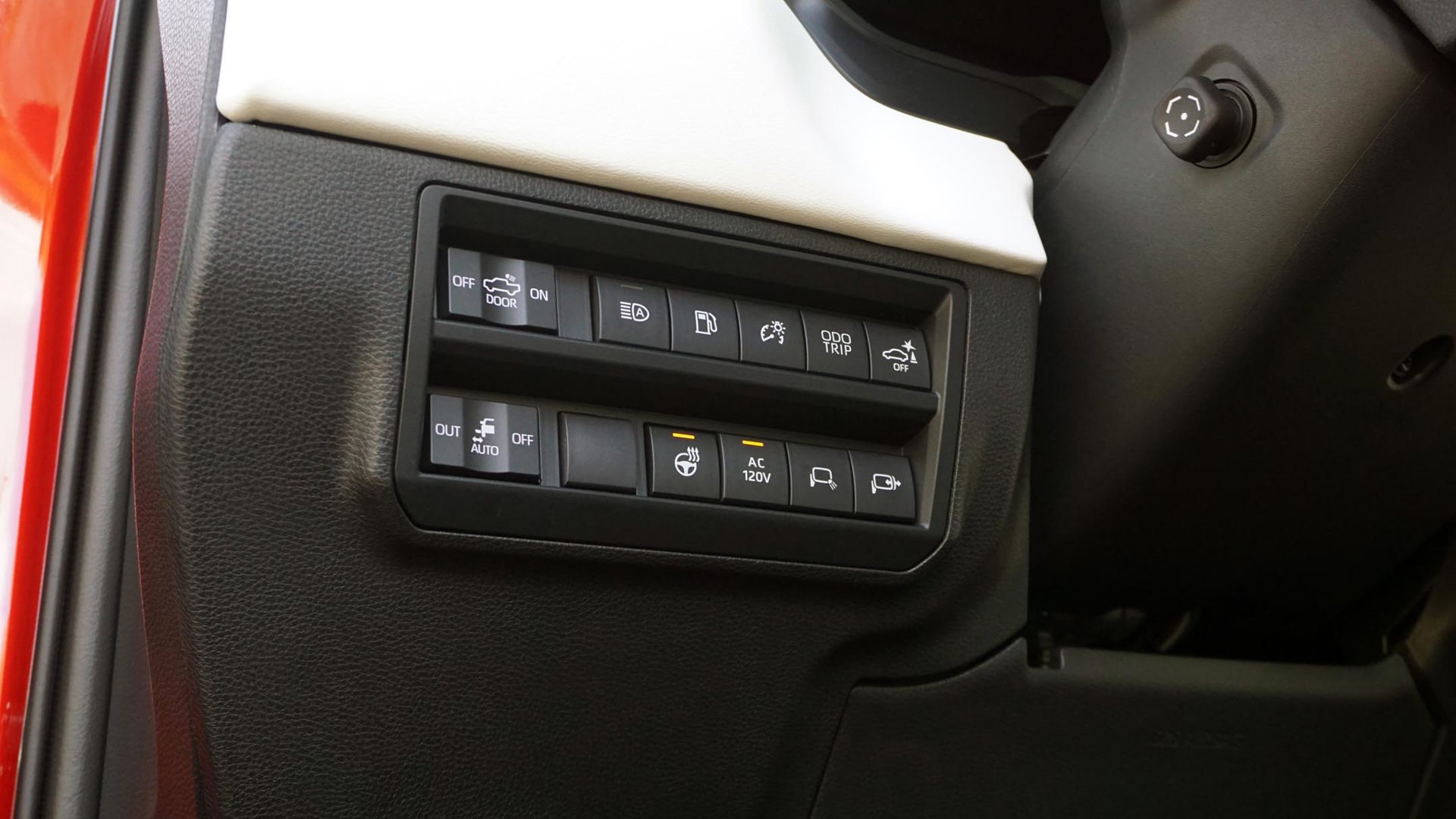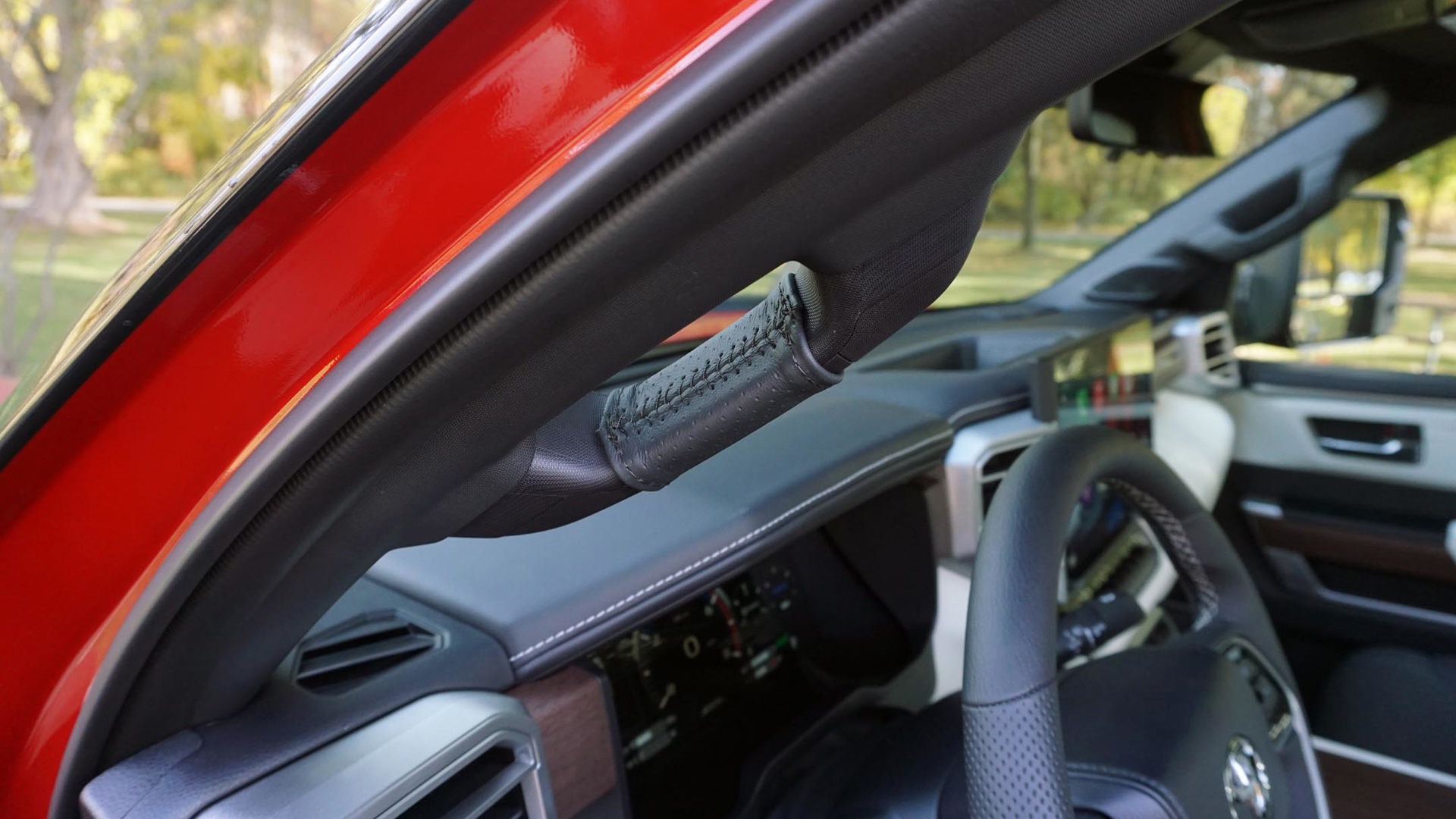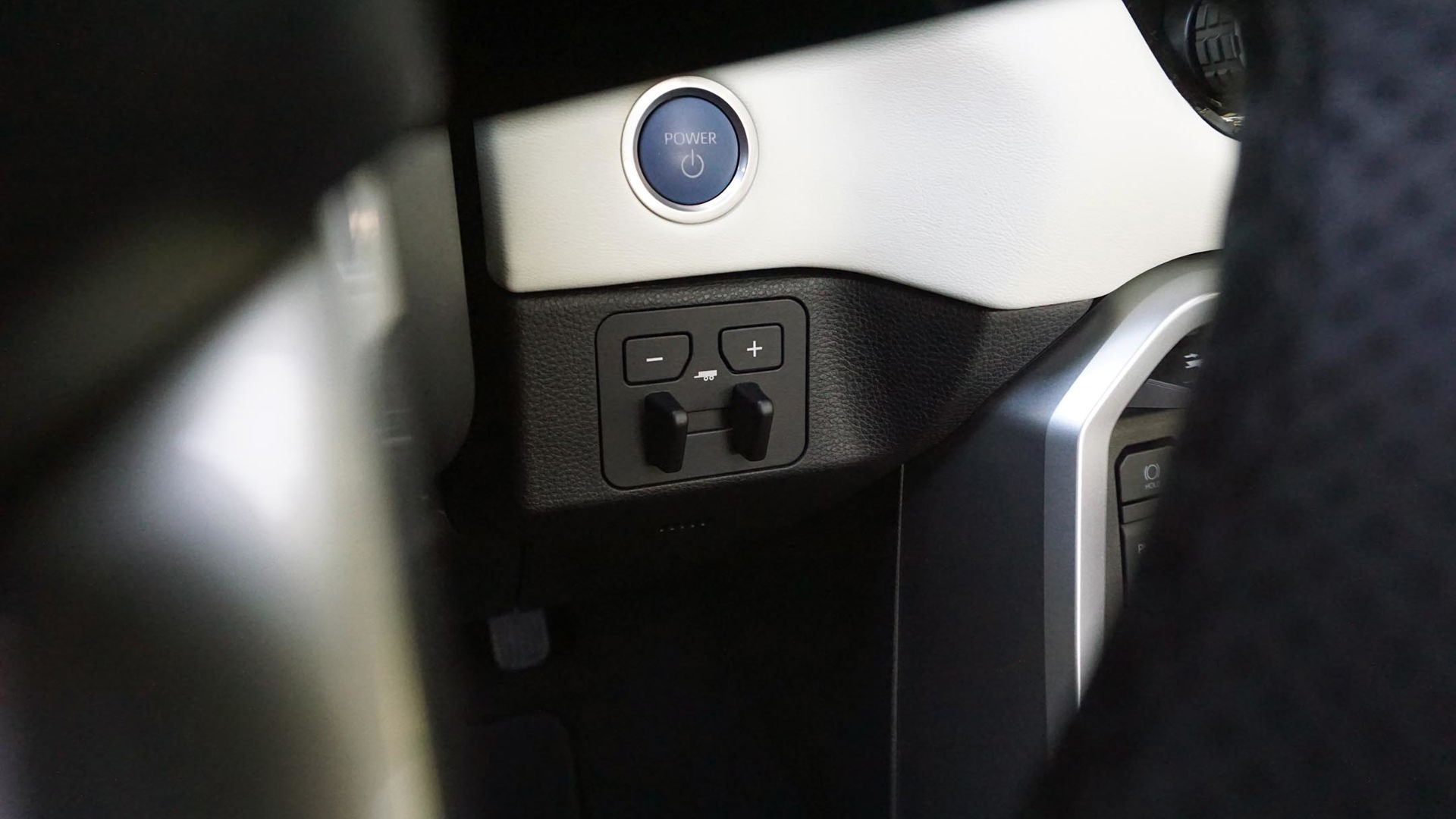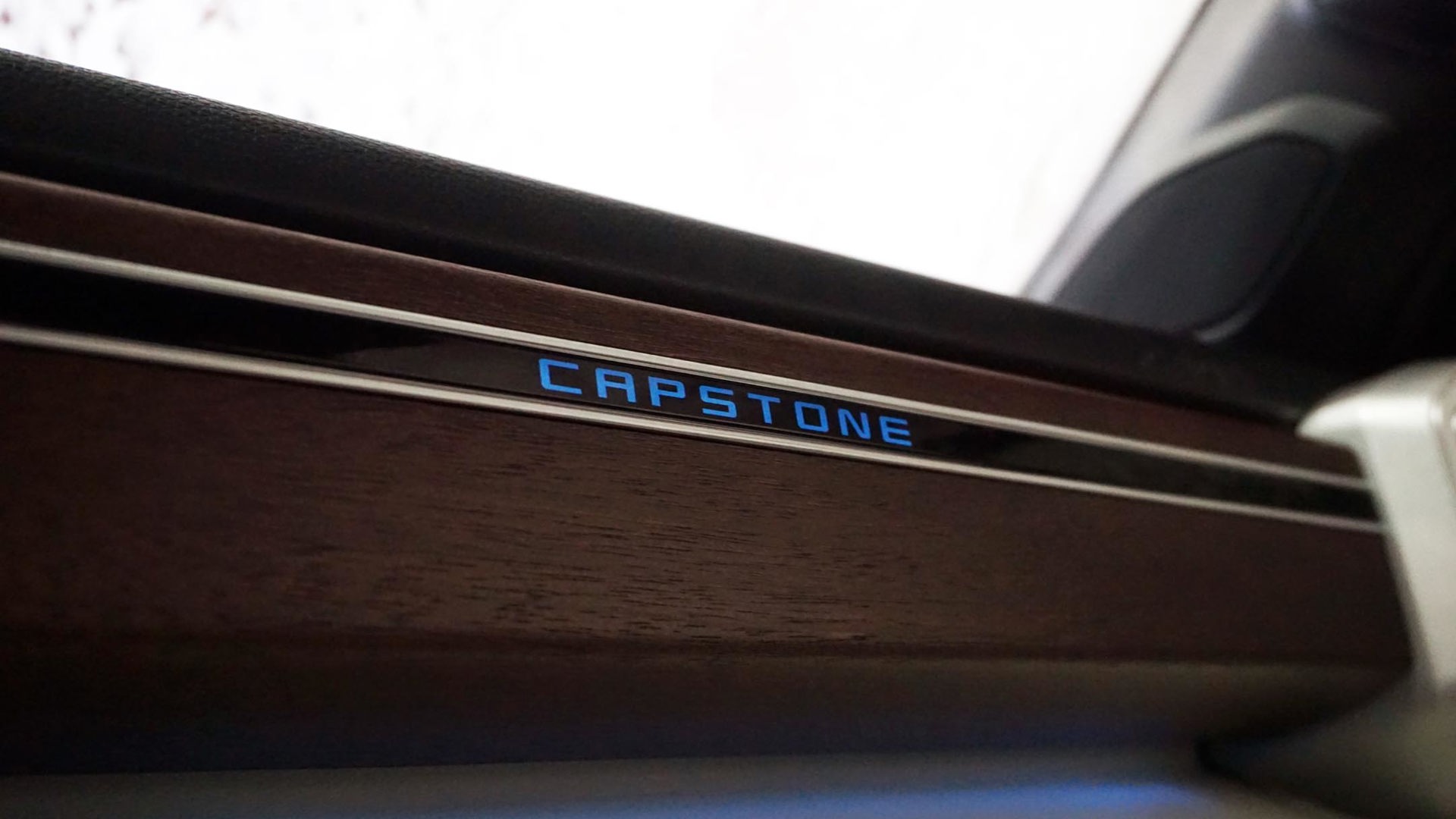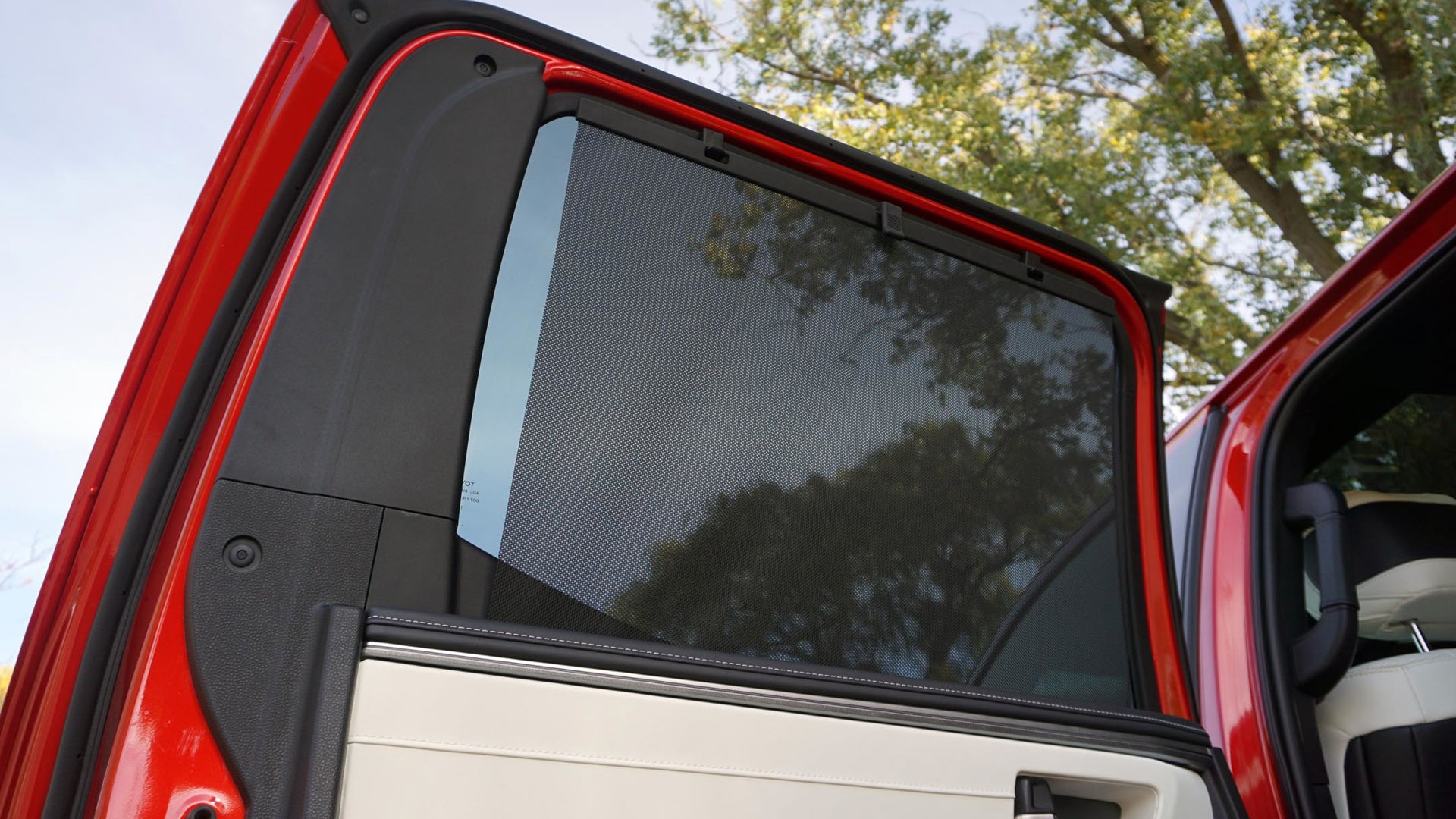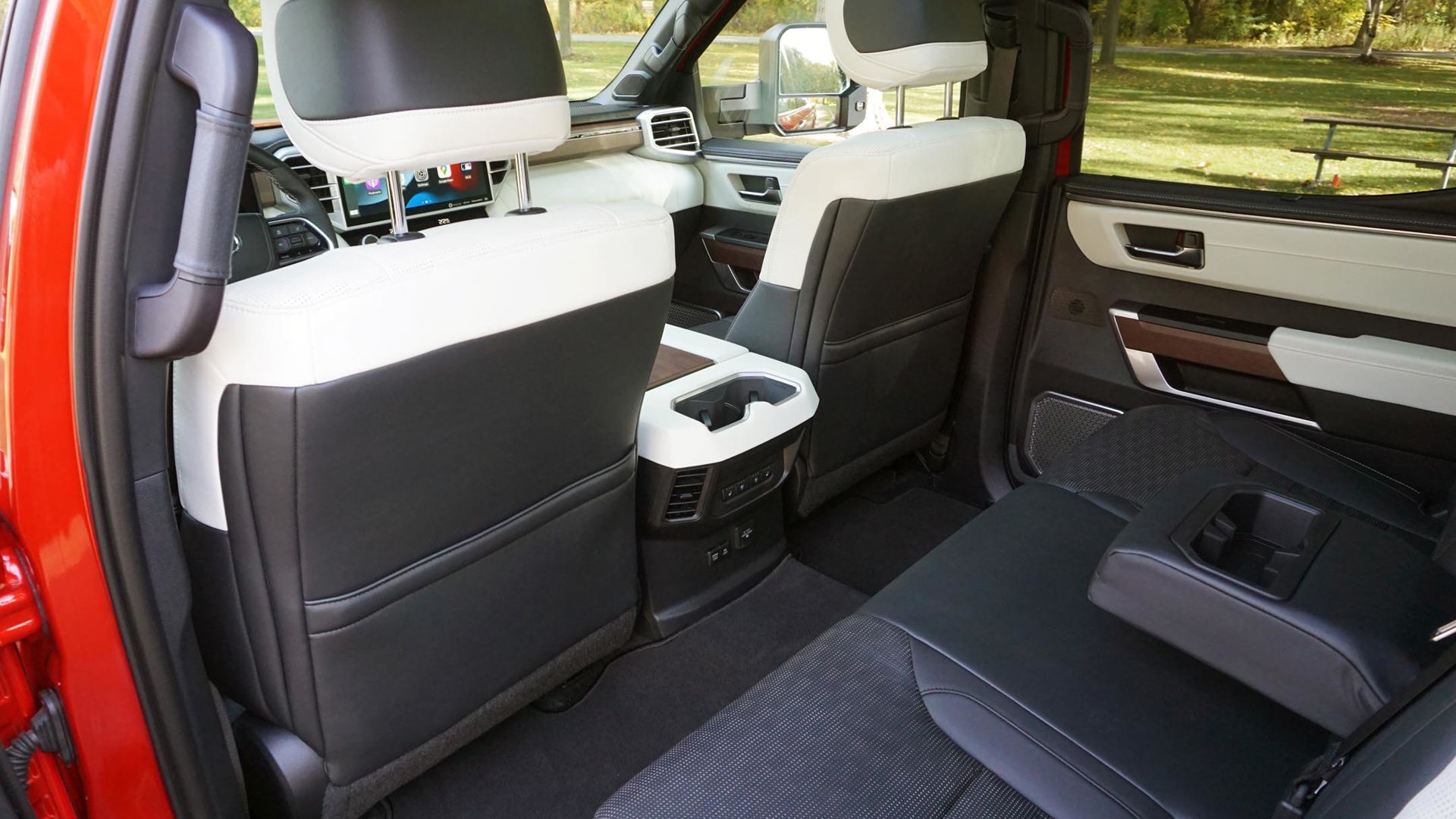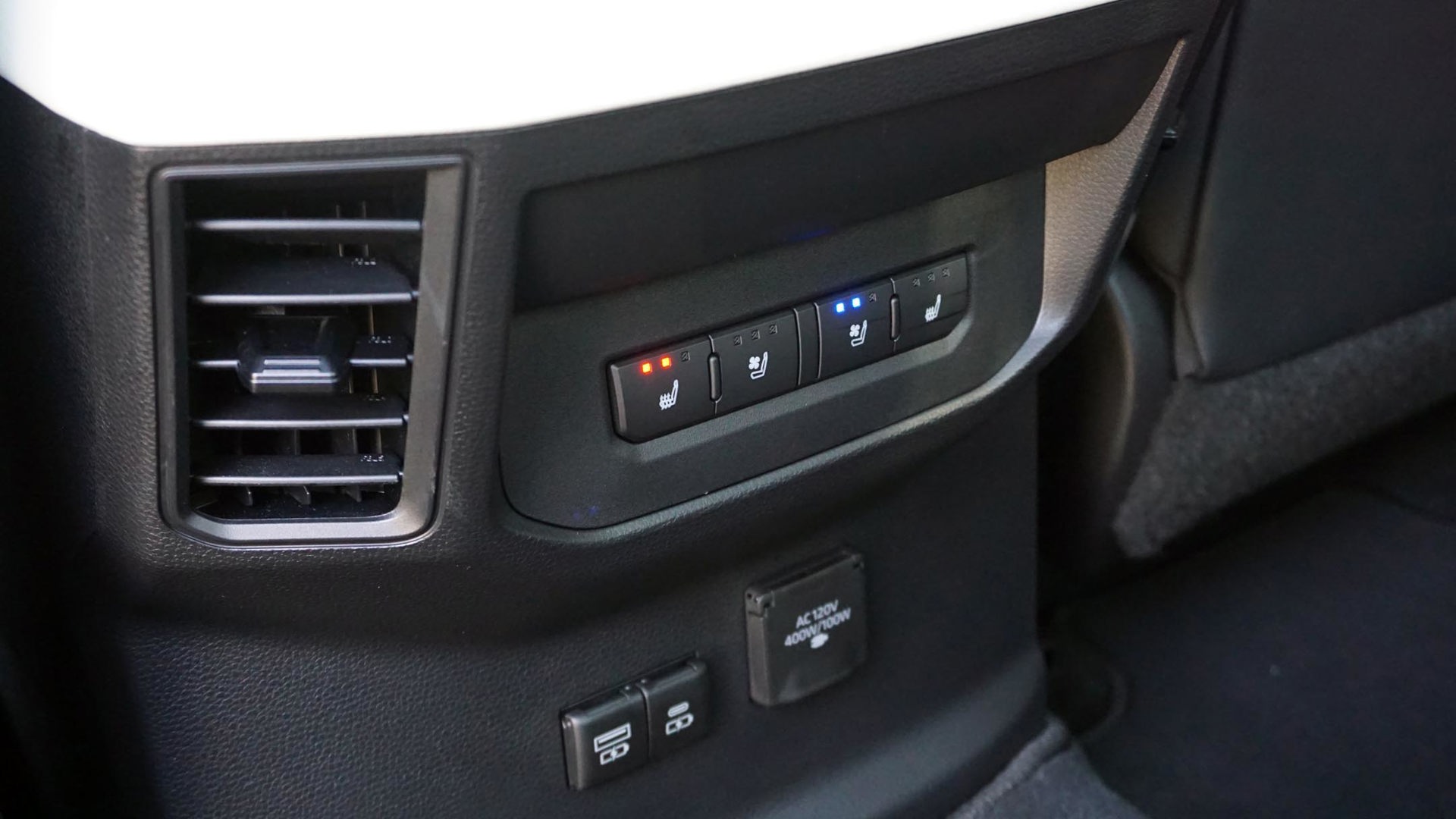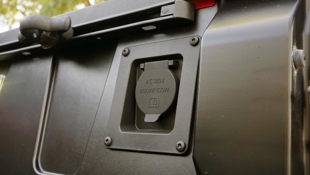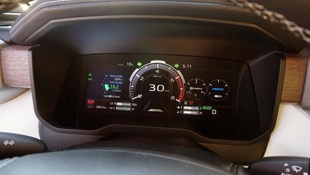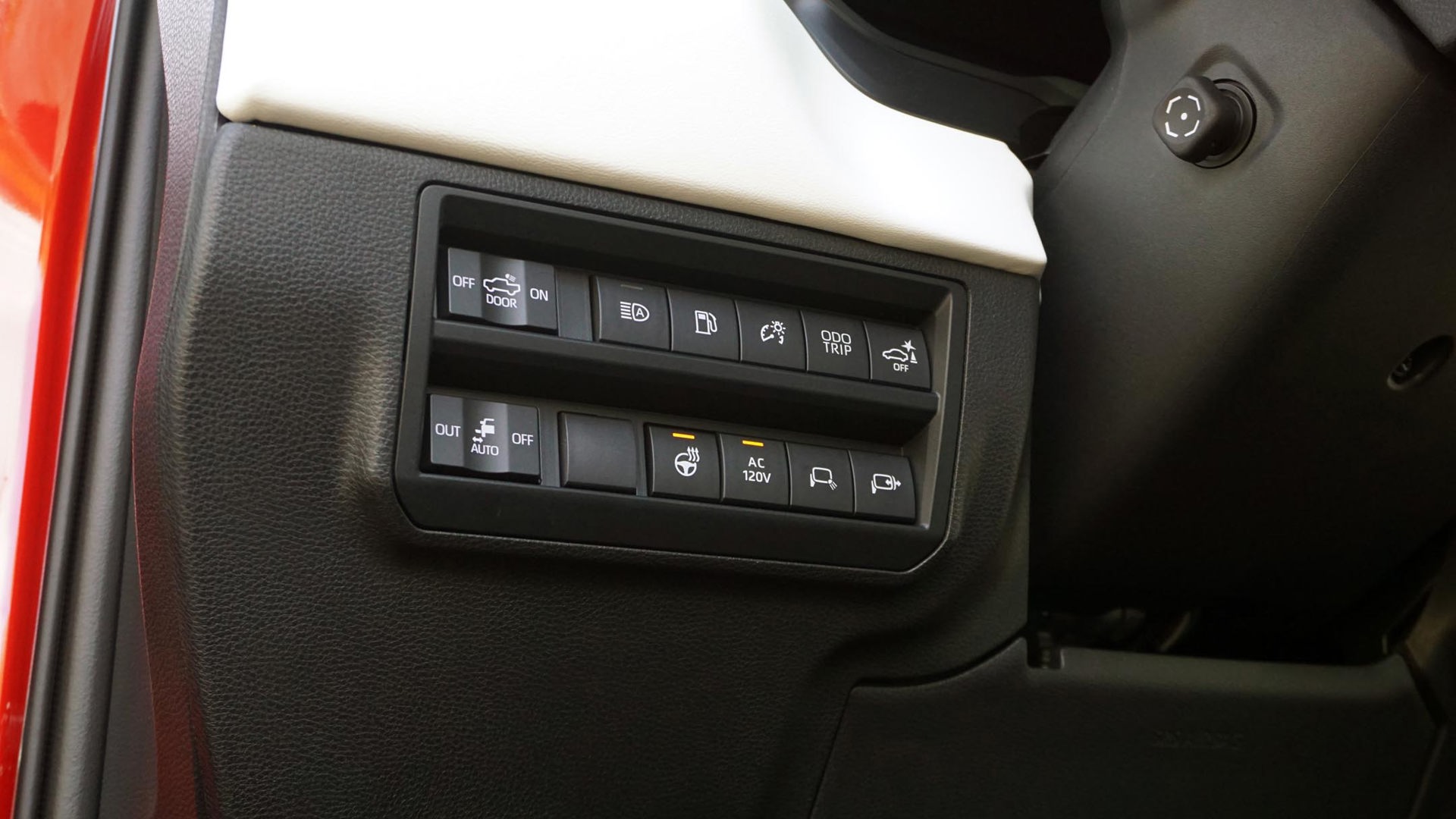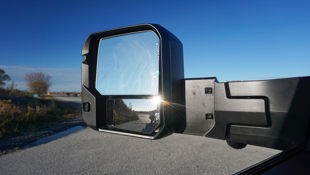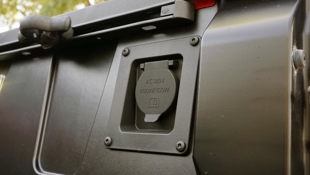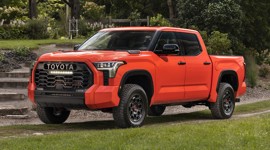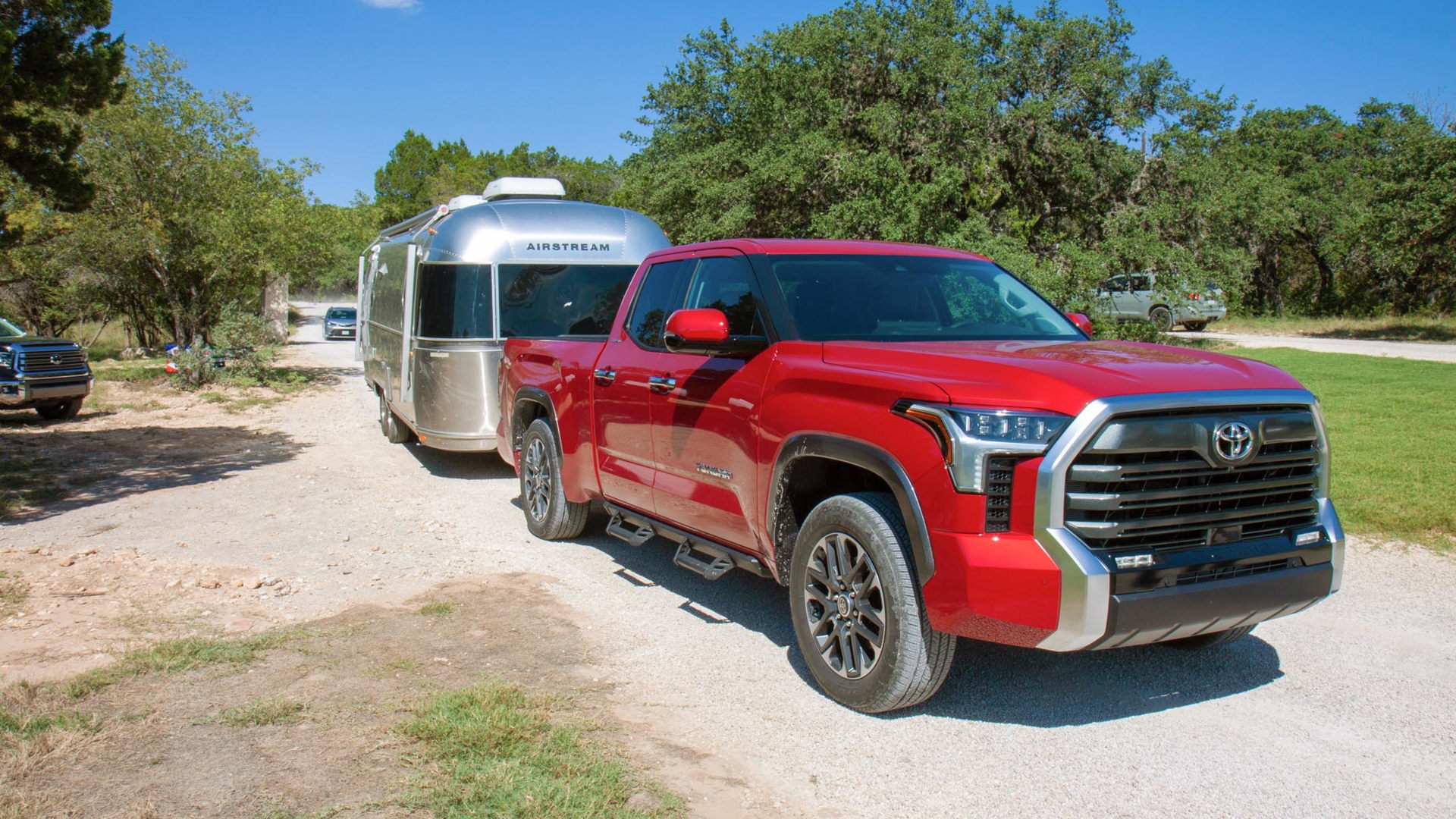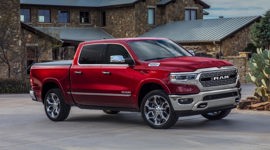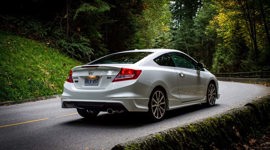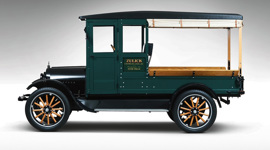If you’re shopping for an efficient gas-electric truck, the 2022 Toyota Tundra Hybrid isn’t it.
Confused? We don’t blame you. But that’s because in spite of its combination of mechanical and electrified propulsion, and the fact it’s built by a brand renowned for its fuel-saving hybrids, this half-ton was never meant to be miserly in the first place.
That’s why you won’t find any badges boasting about its hybrid powertrain – at least not the ones you might expect. OK, the emblem in the middle of the massive grille is accented in blue, which is Toyota’s nod to the combination of gas and electric propulsion it uses for all hybrid models. Otherwise, it’s only the pair of iForce Max wordmarks mounted high atop the hood that provide hints about what’s happening under it.
When Toyota ditched the previous truck’s V8 engine, it tapped two engines as replacements. Well, sort of. It’s actually the same twin-turbocharged V6, but the hybrid version adds an electric motor that’s tucked between the engine and transmission. The result is incredible peak output: 437 hp and 583 lb-ft of torque.
For a little perspective, that torque count handily exceeds those of the half-tons with which the Tundra Hybrid competes. It’s also the kind of stuff that should make quick work of towing or hauling heavy loads – so that’s exactly what we set out to do.
Hybrid Hauler
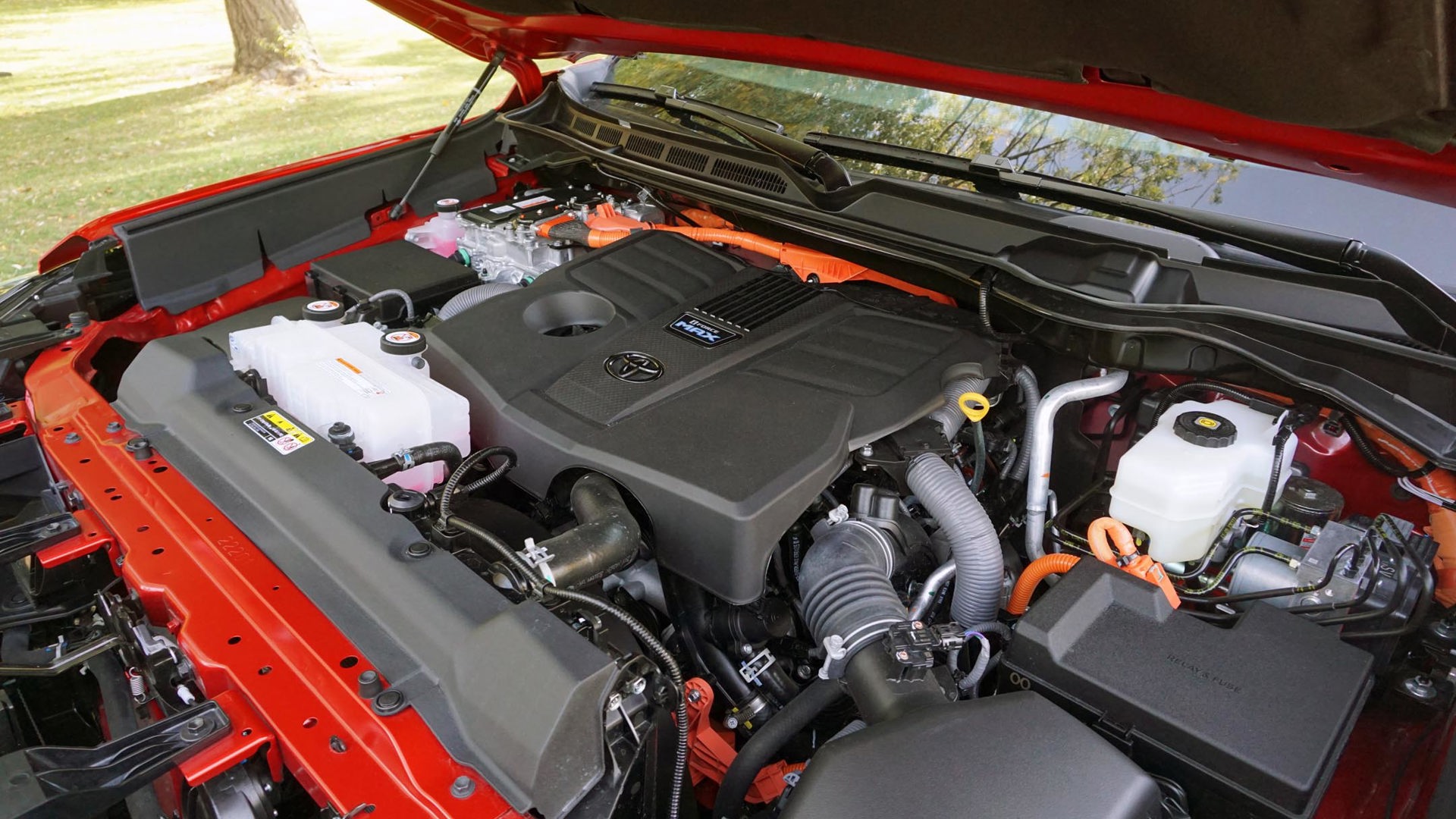
With AutoTrader’s own Jeff Wilson road-tripping his way home from Whitehorse, Yukon, in one of these hybrid-powered trucks – along with an off-road-ready Tundra TRD Pro – and your humble author spending a week with one earlier this year, the overall experience it provides has been covered here ad nauseum. However, this is a hauler just begging to have its on-paper capabilities put to the test.
According to Toyota, this hybrid version’s towing capacity peaks at 5,194 kg (11,450 lb), which is actually a little less than the gas-only version of the Tundra; likewise, skipping the hybrid yields more outright payload, but that’s because of the added weight of the electrical components, which cuts into how much it can safely carry. What we wanted to test was the gas-electric powertrain’s ability to move a massive amount of weight.
While the 3.5L twin-turbo motor makes a maximum of 389 hp and 479 lb-ft of torque on its own – both of which exceed the old truck’s V8, it’s worth noting – this hybrid’s secret weapon is nestled neatly inside the transmission’s bell housing. Making 184 lb-ft of torque (to go with an extra 48 hp), the electric motor is a meaningful addition. Torque is the stuff that gets a vehicle moving, but it’s also highly valued when towing or hauling, which requires a bit of brute force to do well.
Since the very nature of electrified torque is instantaneous, it’s the perfect solution to the problem – particularly with the turbo lag that’s common in this kind of forced-induction engine. The extra low-end grunt works to fill in the gap before the gas engine’s torque kicks in, so there’s no waiting for the turbos to spool up higher in the rev range. (For those wondering why the math doesn’t quite add up here, fear not. Net output is the peaks at which the two power sources can operate simultaneously rather than a simple combination of their maximums, hence why the 583 lb-ft of net torque is less than the gas engine and electric motor each generate on their own.)
The Details
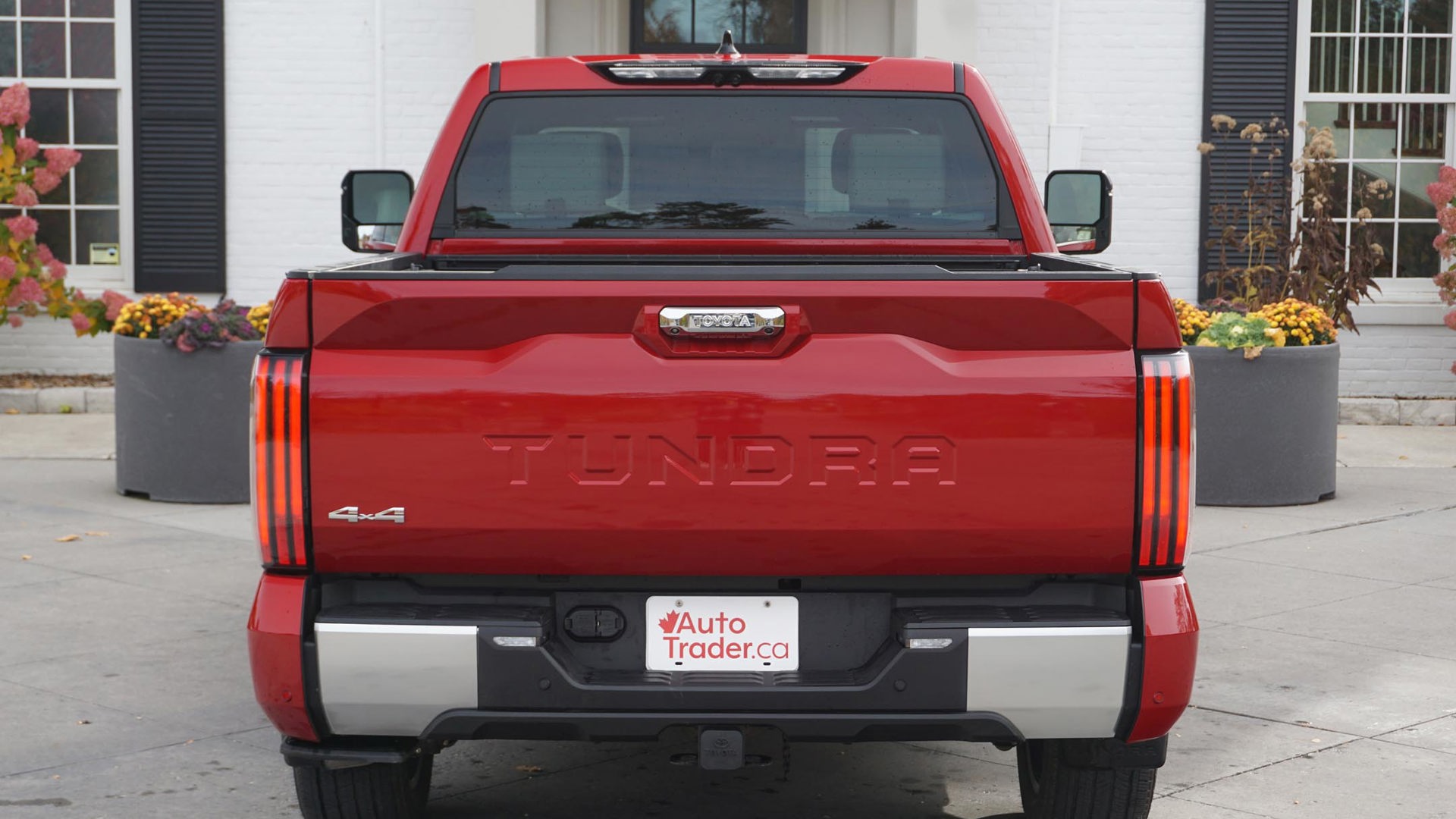
While the Tundra Hybrid’s output is unchanged regardless of trim, the specifics as far as how much weight it’s rated to move fluctuates. In the case of the range-topping Capstone version tested here, towing capacity stands at 4,690 kg (10,340 lb), while maximum payload – that’s the weight that can be hauled in the cab, bed, or both – is 675 kg (1,488 lb). In Canada, where all Tundra Hybrid trims feature selectable four-wheel drive, the TRD Pro version boasts the most towing capacity at 5,069 kg (11,175 lb), while the Limited with its available 6-foot-5 bed can haul the most at 755 kg (1,665 lb).
This tester was also fitted with all kinds of handy towing and hauling features, some of which are standard across the hybrid lineup. There’s a hitch, of course, and it comes with four- and seven-pin connectors; plus there’s blind-spot monitoring that works with a trailer hooked up to the back, a selectable tow/haul setting for the drivetrain, and a built-in trailer brake controller. Higher up the trim ladder there’s stuff like auto-levelling headlights, power-extendable tow mirrors, a few rear camera views, and a trailer back-up assist system that can reverse a registered trailer in a straight line using automated steering inputs.
The only noteworthy feature missing from this 2022 Toyota Tundra Hybrid Capstone tester is load-levelling suspension. Available optionally with the Platinum trim, the system compensates for suspension sag by pumping up rear air springs. Otherwise, it’s fully kitted out – and rightfully so for its $86,295 pre-tax asking price.
The Towing Test
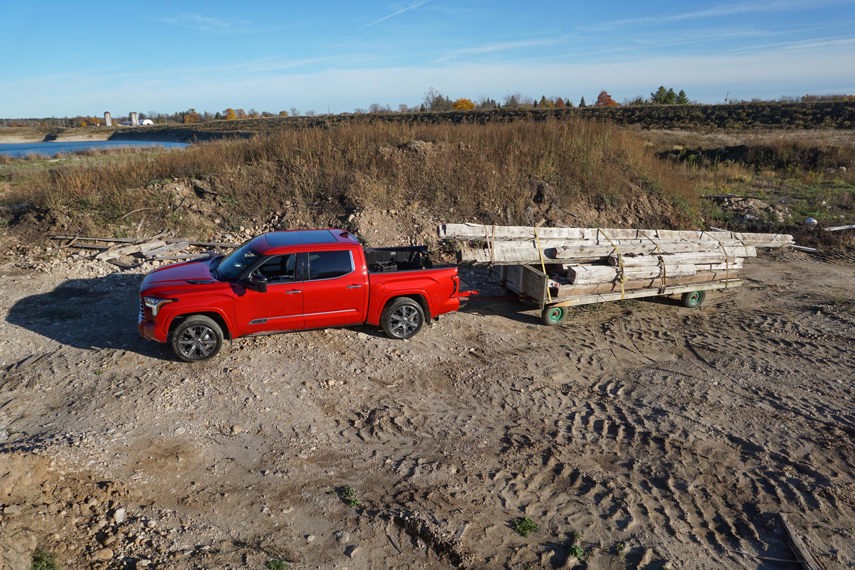
With a friend in need of a load of old barn beams shuttled from one rural property to another, it was time to see what this truck could do. Between the trailer itself and the beams, some measuring upwards of six metres (19.7 ft) long, the load weighed an estimated 4,536 kg (10,000 lb) – within the truck’s limits, albeit barely.
Making the test tougher was the trailer’s starting point. Long since abandoned for agricultural use, the property wasn’t exactly a neatly manicured one – at least not where the trailer sat parked. It would be an uphill battle in a literal sense to get the double-axle unit dislodged from its months-long resting place and onto flatter ground for the six-km journey ahead.
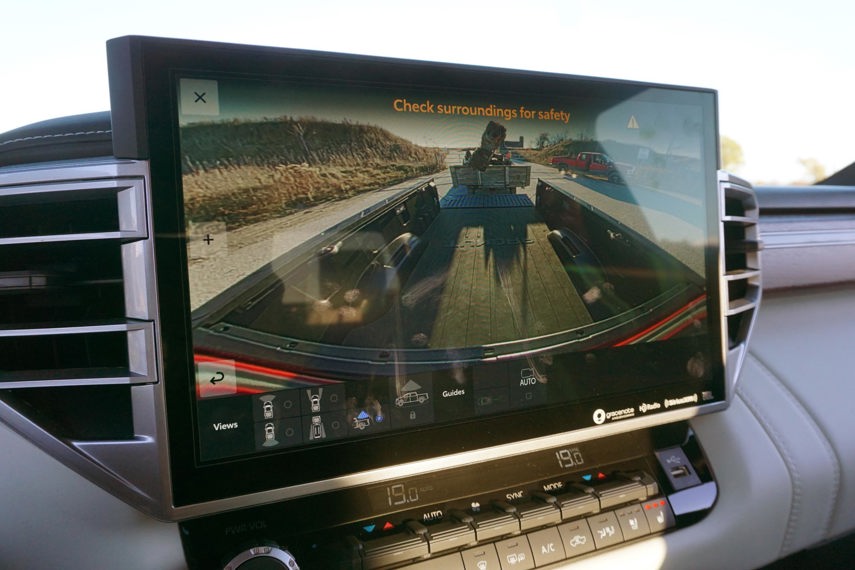
With the transfer case in its low-range setting for maximum grunt and a gentle poke of the throttle pedal, there was barely a noticeable pull at the hitch pin as the stubborn old trailer crept forward with ease. Carefully crawling over rocks and debris, the Tundra was barely breaking a sweat. And while the double-axle design of the trailer reduced tongue weight, there was barely any indication that this truck was nearly at its limits in terms of towing.
Reaching the property’s main entrance, the transfer case was disengaged to run in rear-wheel drive. The pivoting front axle meant it would be a slow ride along the unpaved shoulders of these rural roads, with anything beyond about 30 km/h causing it to drift and wander unnervingly behind the Tundra. Even at that speed – and with the route made up of a few subtle hill climbs – there was more than one occasion when the gas engine shut itself off completely, allowing the truck to run on the electrons stored in the 1.87-kWh battery pack stowed under the back seat.
The Drawbacks
If there was a noteworthy downside to this truck it would be its abhorrent inefficiency. While it may not be a fuel-saving hybrid, this Tundra managed to burn gas at a rate that would make its official numbers blush. Towing made up only a small portion of this test, and yet it consumed some 13.8 L/100 km across a total of about 420 km, most of which were racked up on the highway. By comparison, it’s rated to return a combined 11.7 L/100 km.
More generally, that the Tundra lacks the automatic setting for its four-wheel drive system that each of its contemporaries offers simply shouldn’t be the case – not for such a new entry. Other issues are minor, including awkward passenger-side mirror magnification that made it impractical to use when retracted, and just 400 watts of output from the bed outlet, as well as a power-deployable bed step that can’t be controlled independent of the powered running boards; if the latter are shut off, the bed step won’t pop out when the tailgate is opened.
Final Thoughts
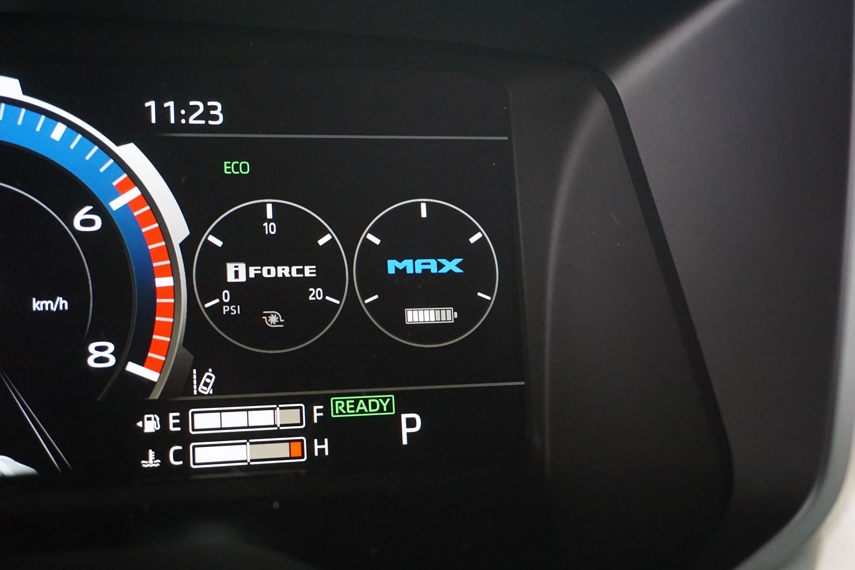
The hybrid moniker is something of a misnomer here – at least when it comes to the way our brains have been programmed to think about powertrains that combine gas and electric propulsion. Rather than efficiency, this hybrid is all about effort, which requires an entirely different mindset. In that way, it’s a bit like finding packages of Beyond Meat next to ground beef in the grocery store: the plant-based protein may be a meat alternative, but meat it is not.
As an alternative to the V8 engines typical of half-ton trucks built to tow and haul, however, this gas-electric setup is more than just a novel concept. With the electric motor doing the heavy lifting (or pulling) until the turbochargers kick in, there’s effectively no time spent waiting for the torque that’s needed when towing. This test may have been short, but it was certainly challenging – and yet the Tundra made surprisingly easy work of it. Sure, the trailer’s design reduced tongue weight, but pulling upwards of 4,500 kg is impressive in spite of that handicap.
Beyond the powertrain, the 2022 Toyota Tundra Hybrid is easy to manoeuvre with or without a trailer hooked up to the back, while the interior might be the most well designed and easiest to live with in the half-ton segment. It even boasts a strong value proposition, with this crew cab-only version ranging from about $68,000 to $86,000 before tax. The Tundra Hybrid may not be the efficient half-ton you were looking for, but as far as hardworking haulers go, it’s certainly got the goods.
